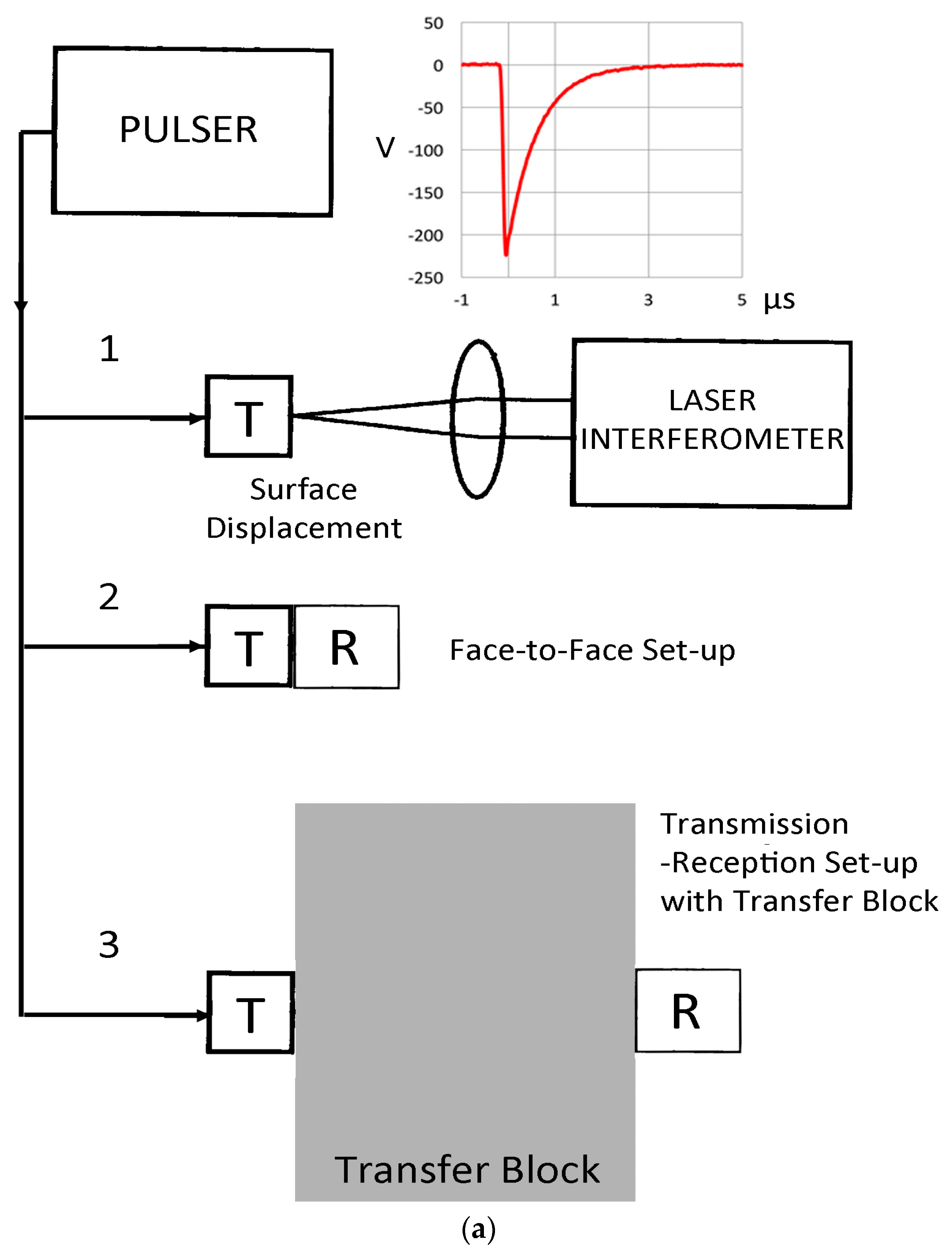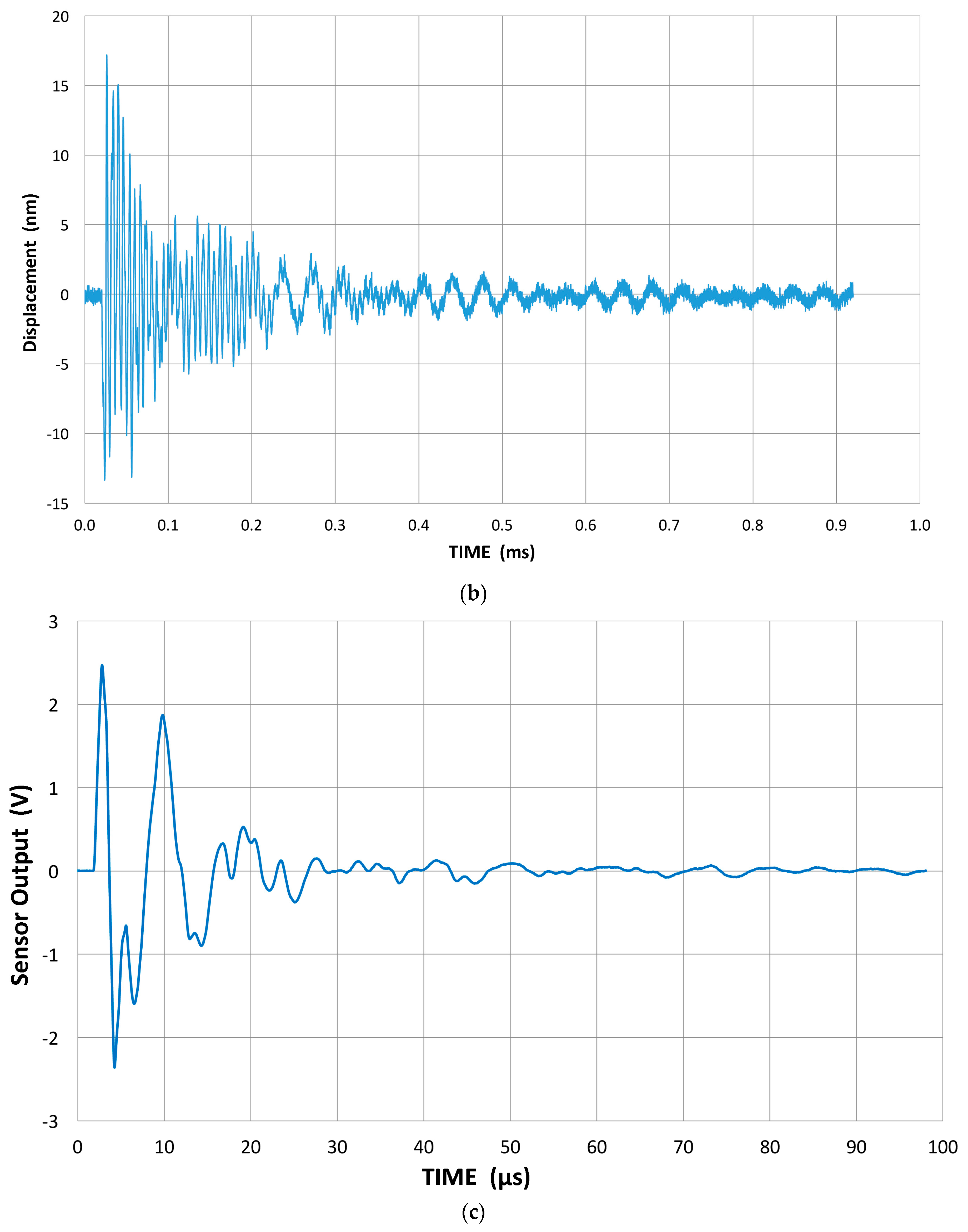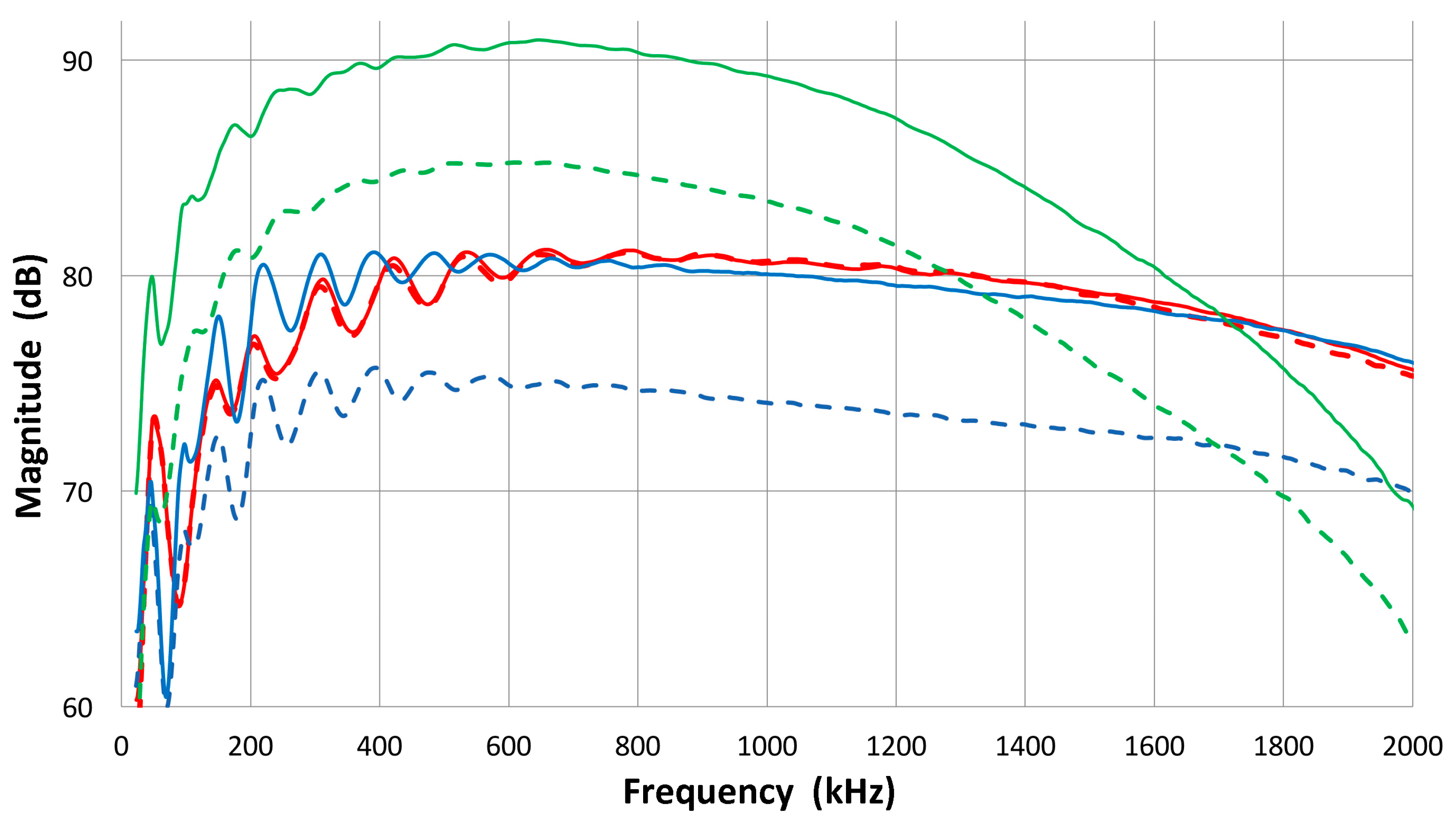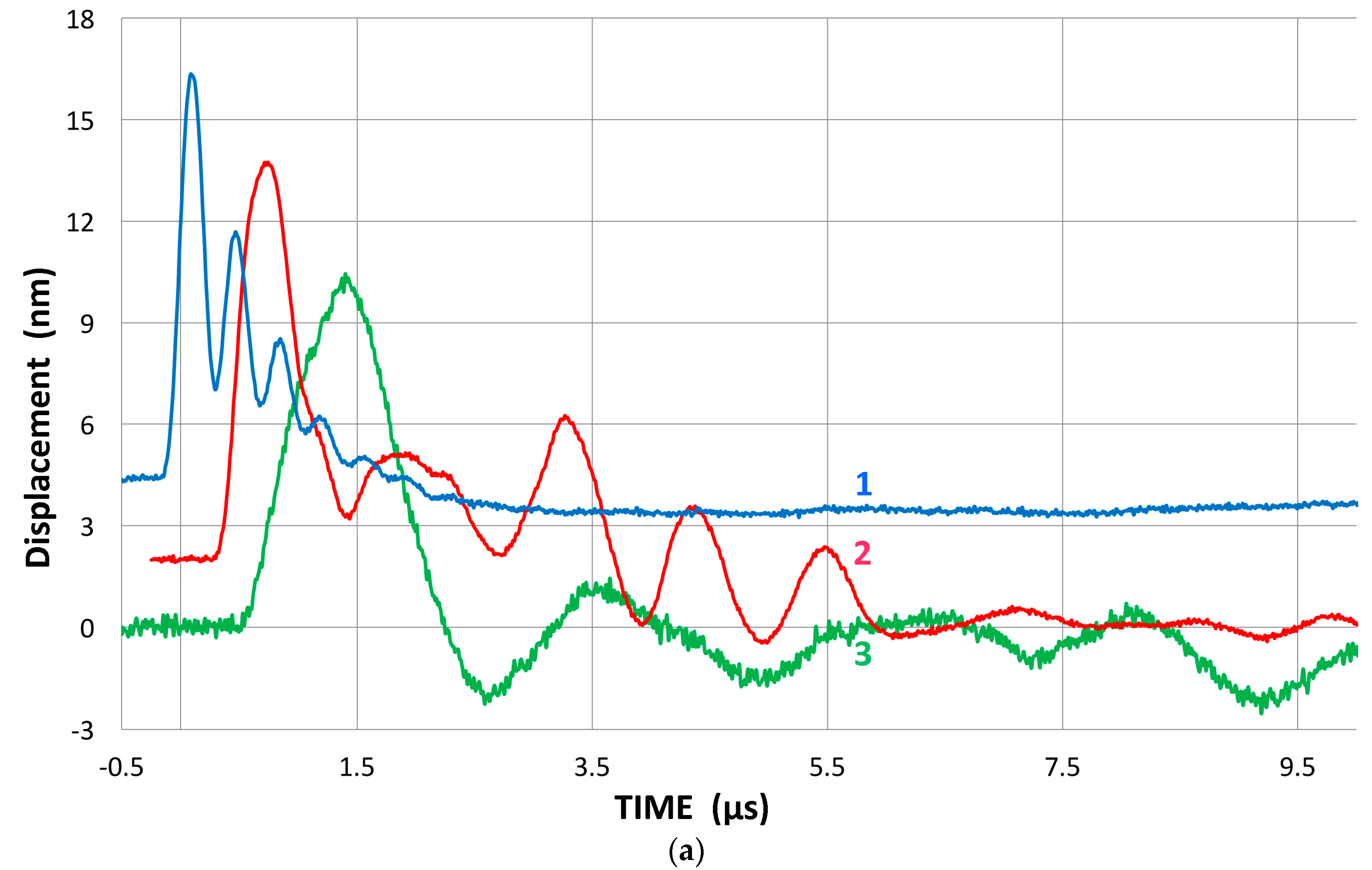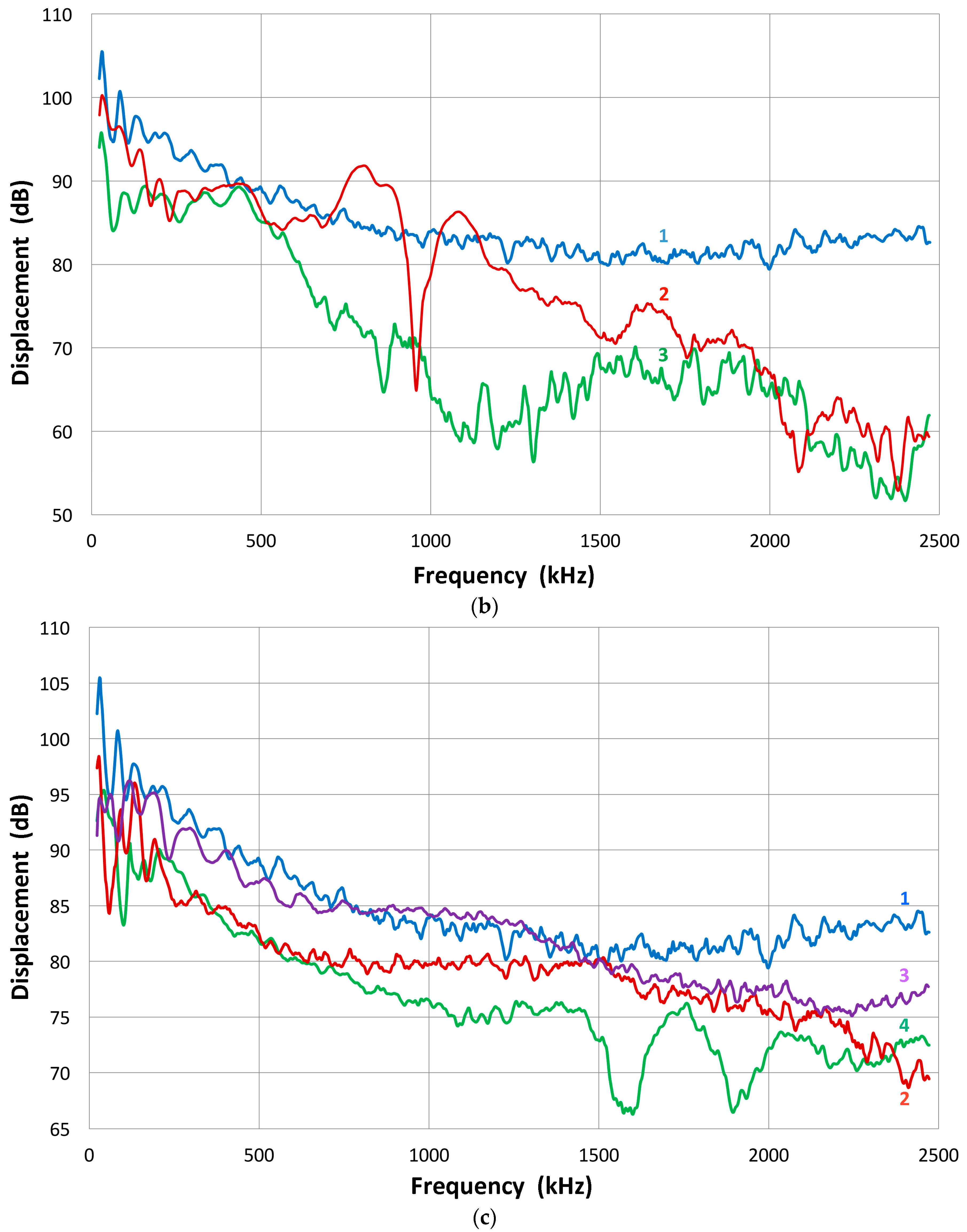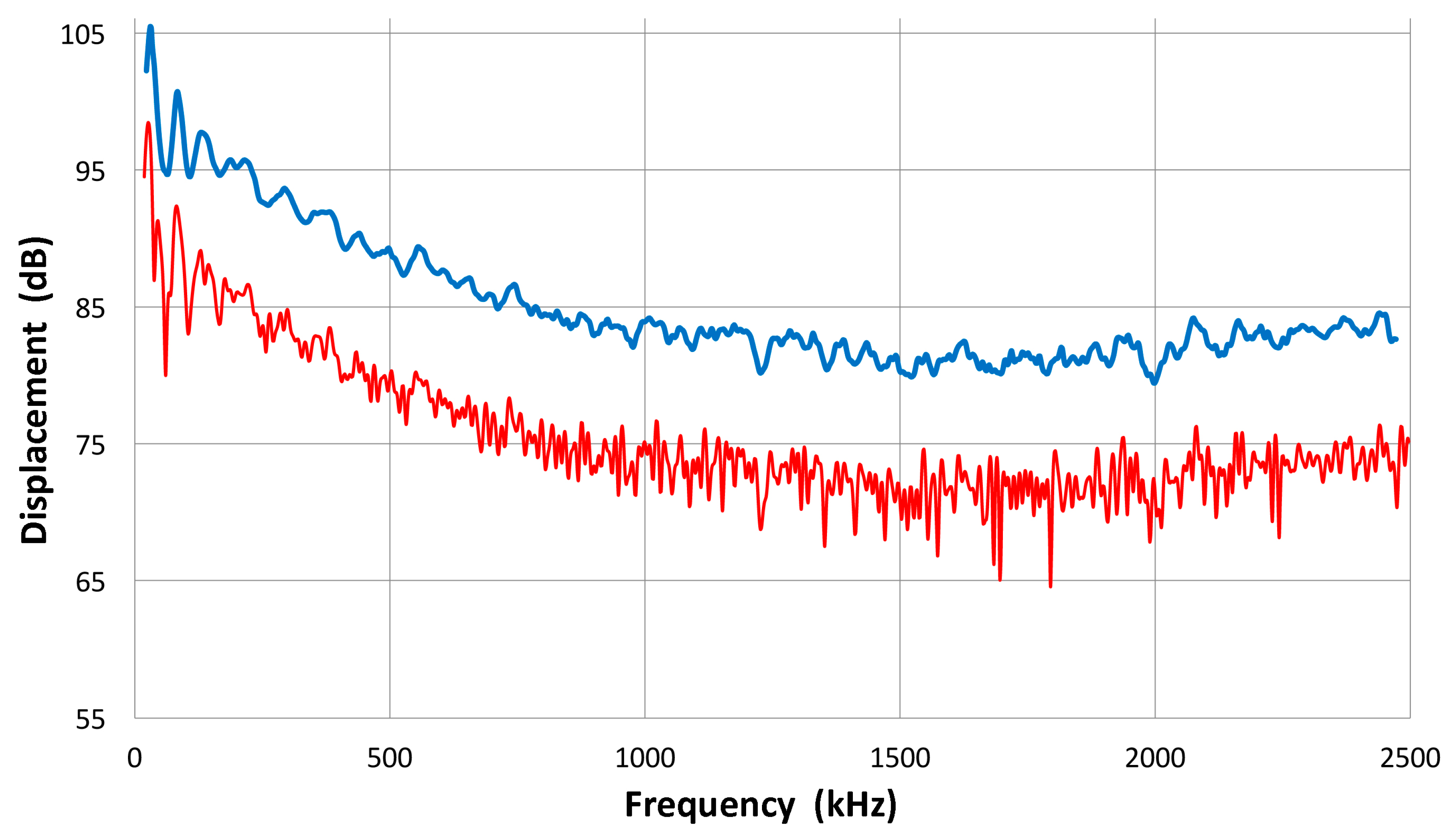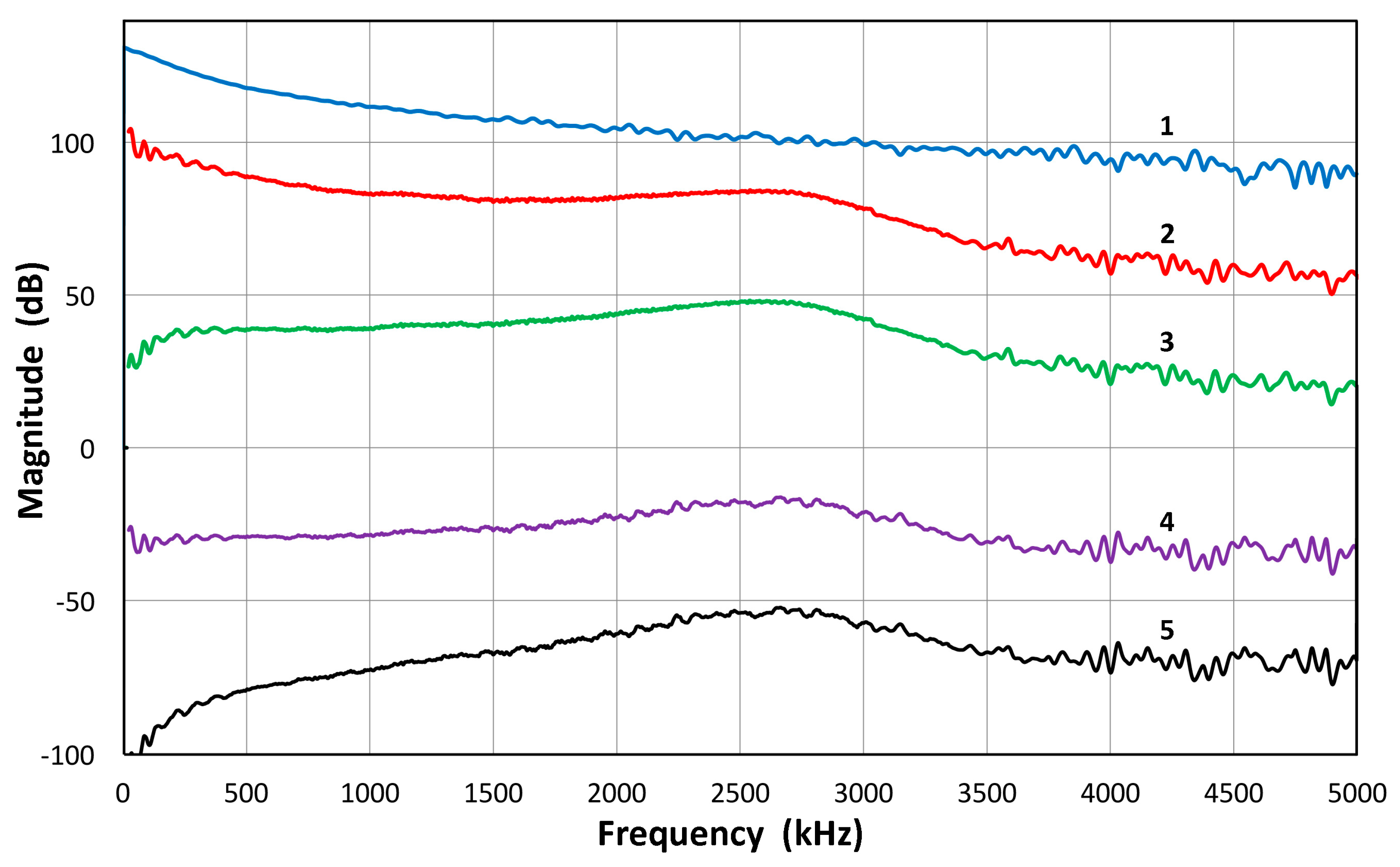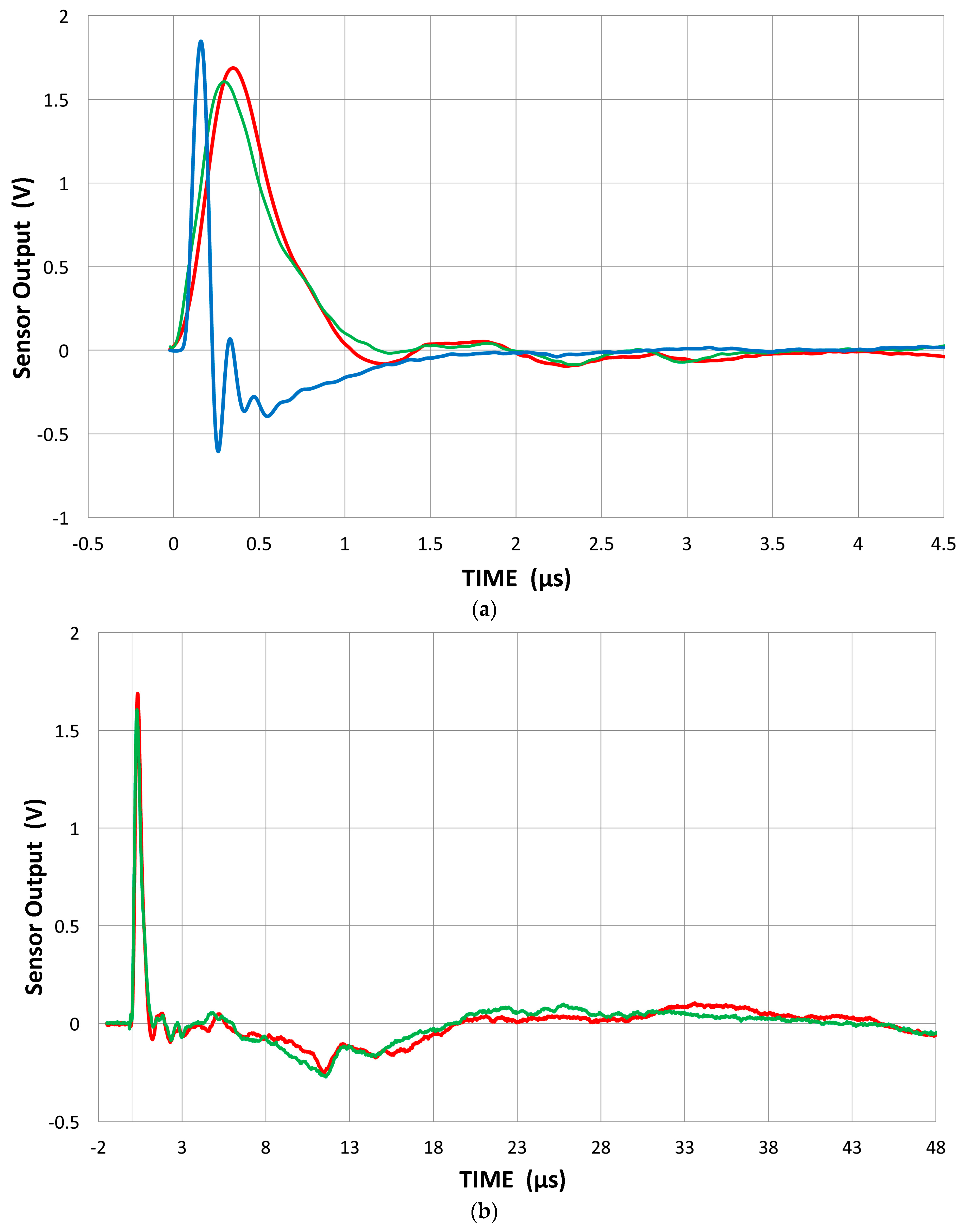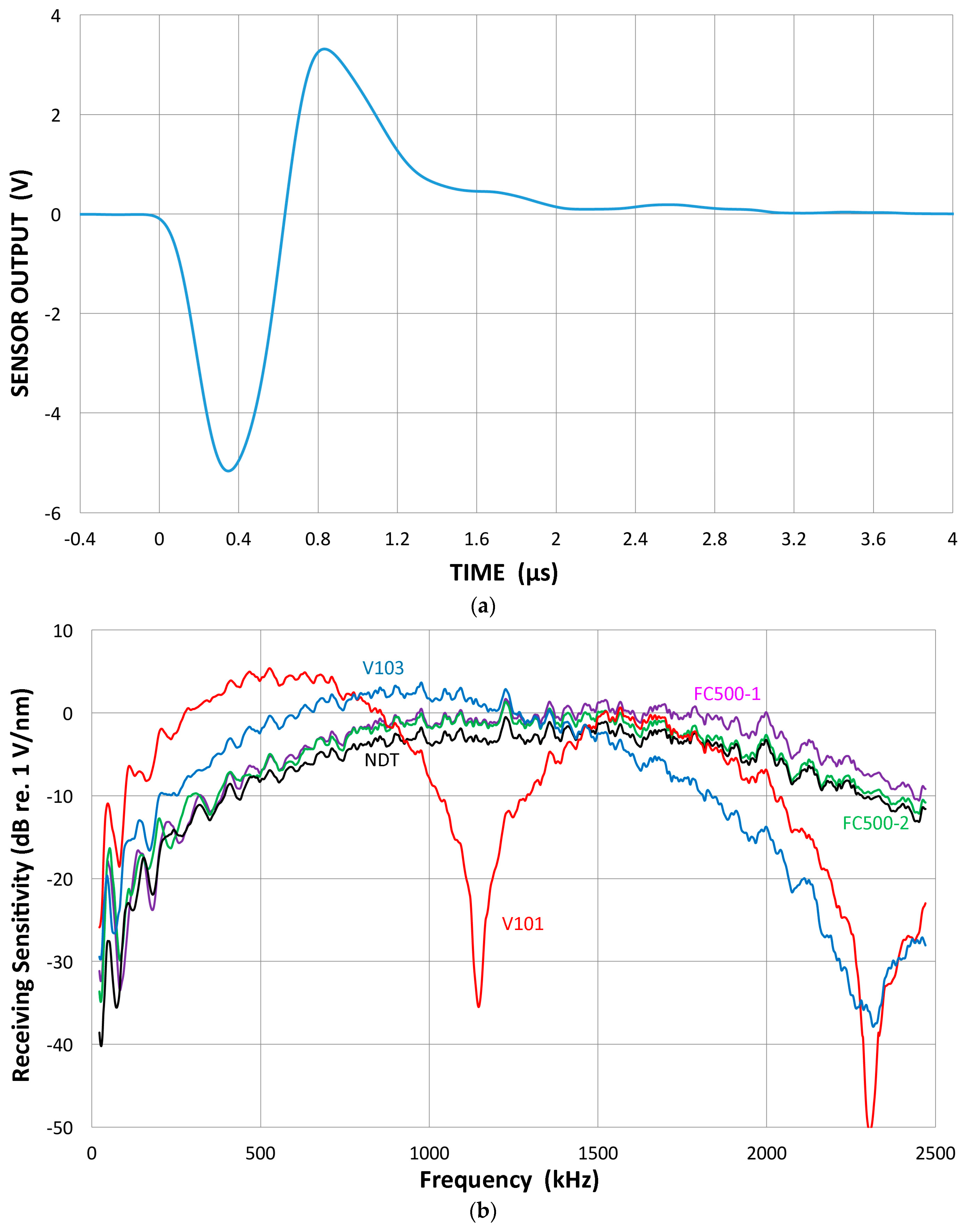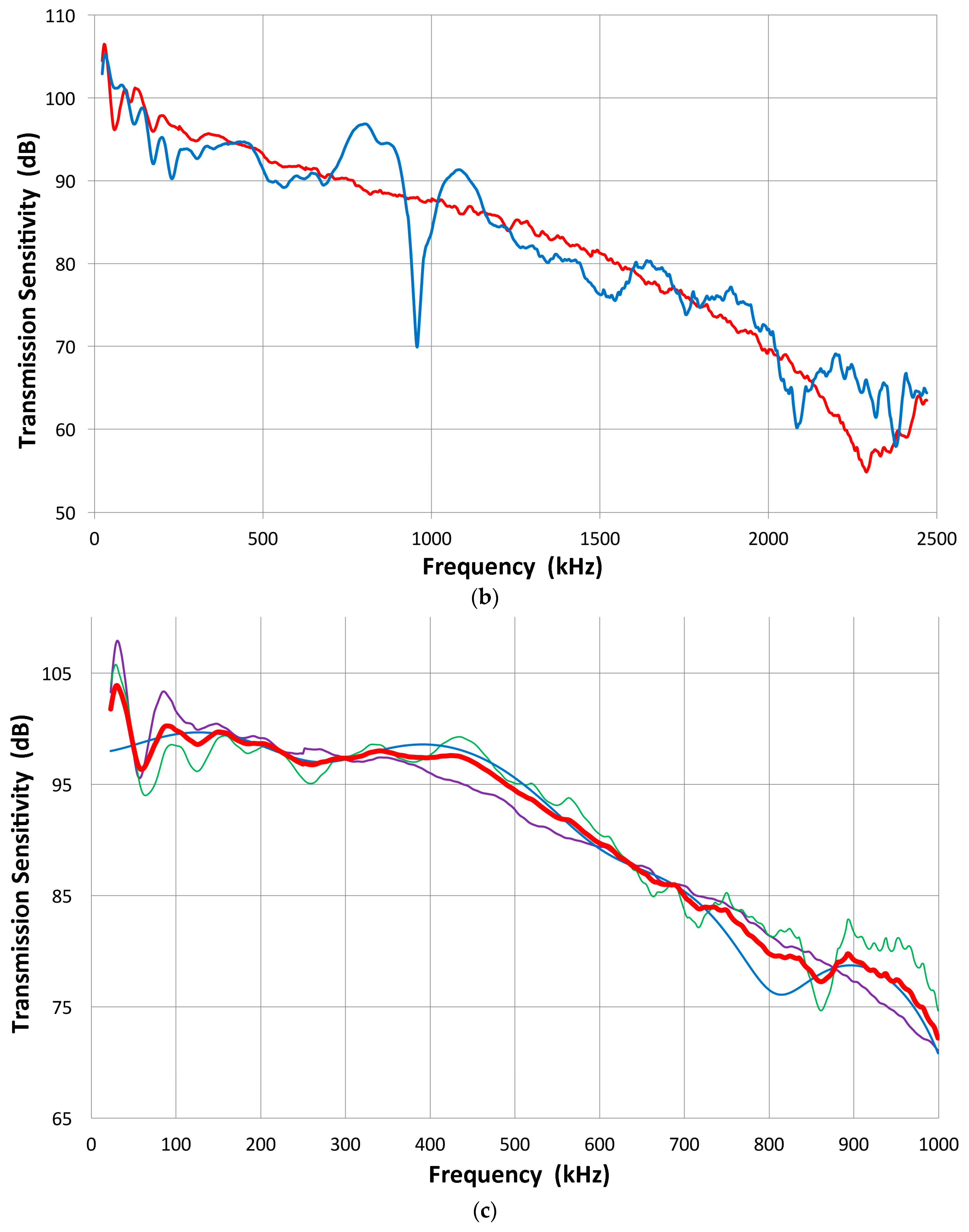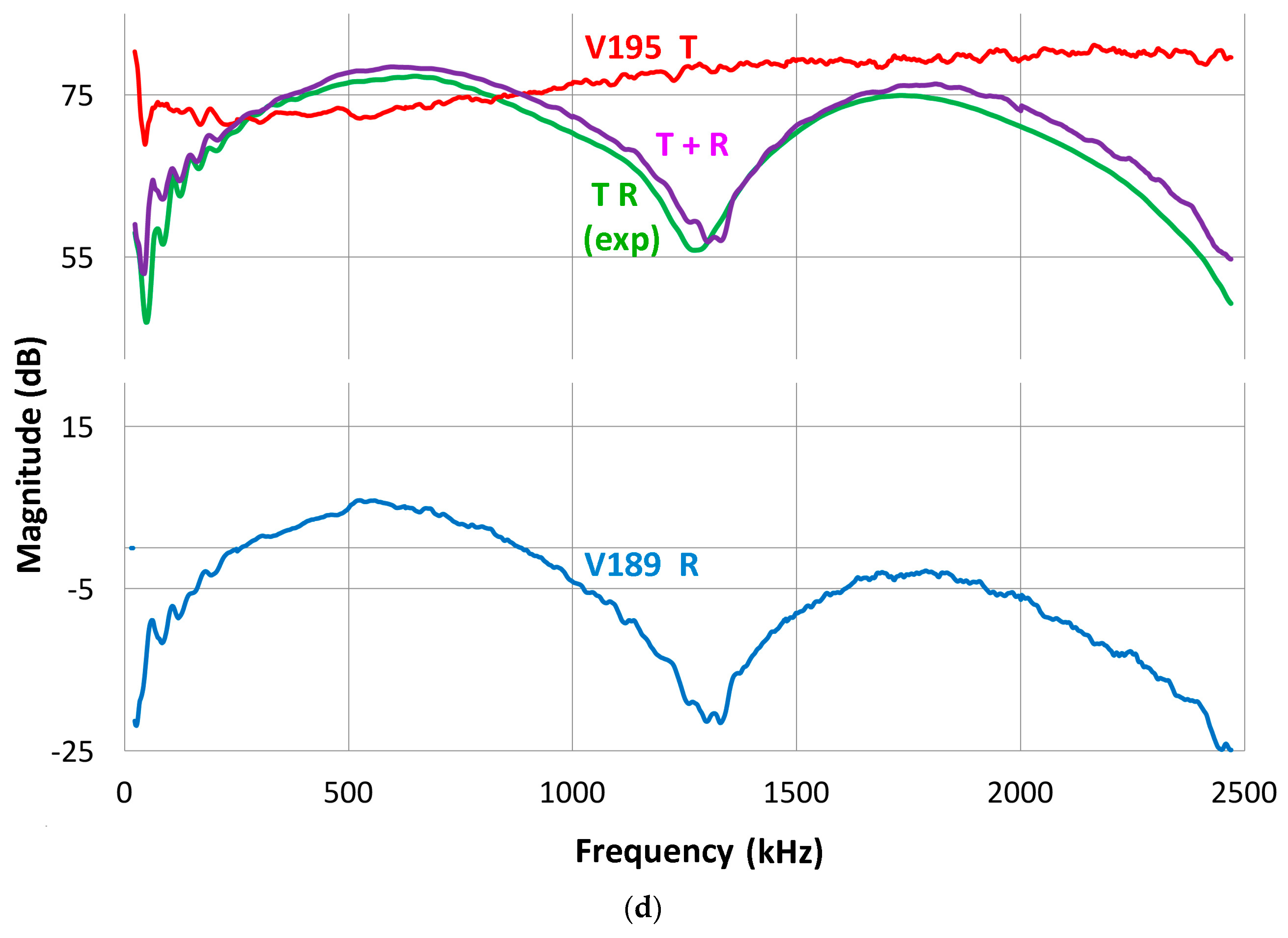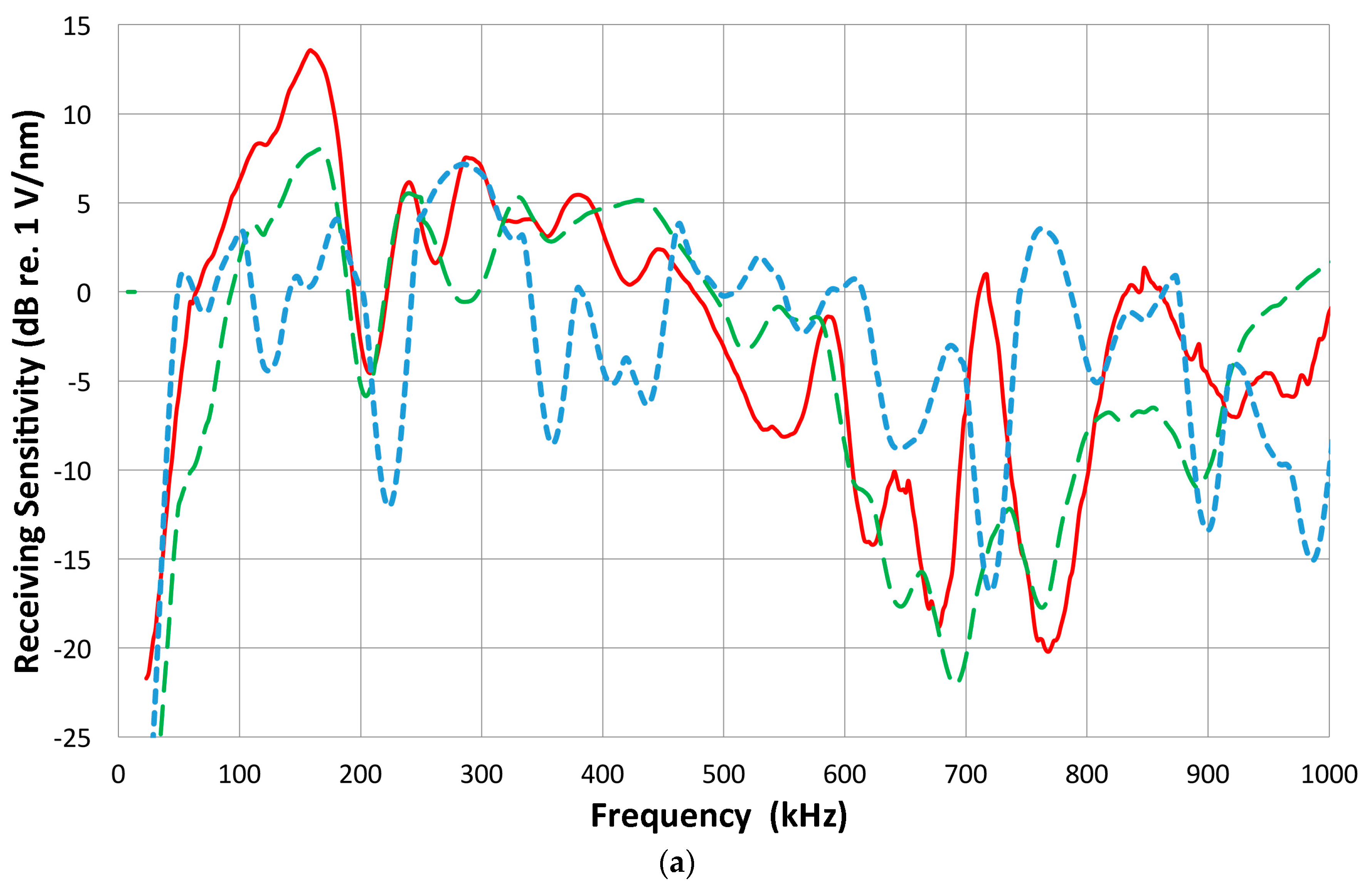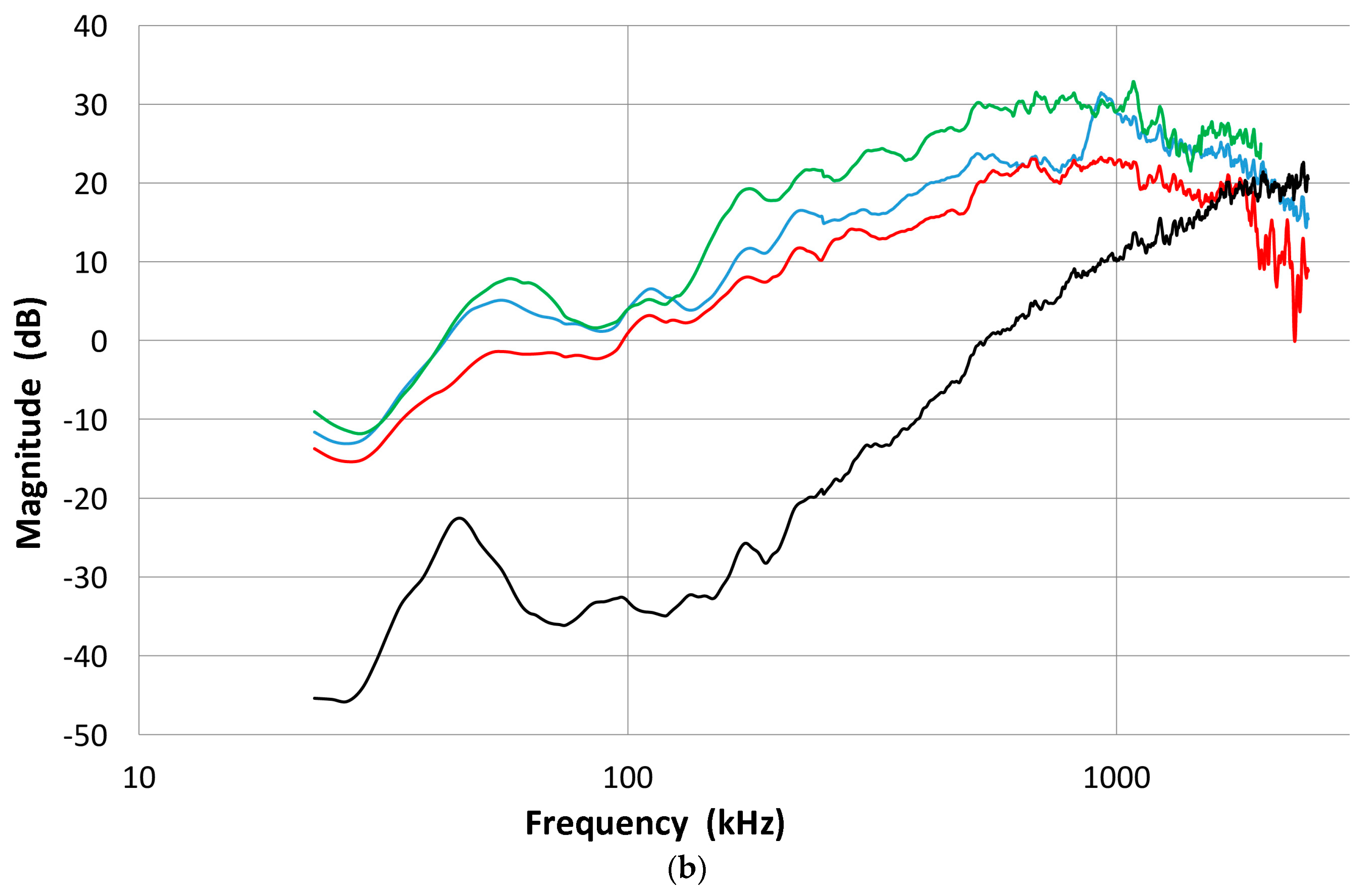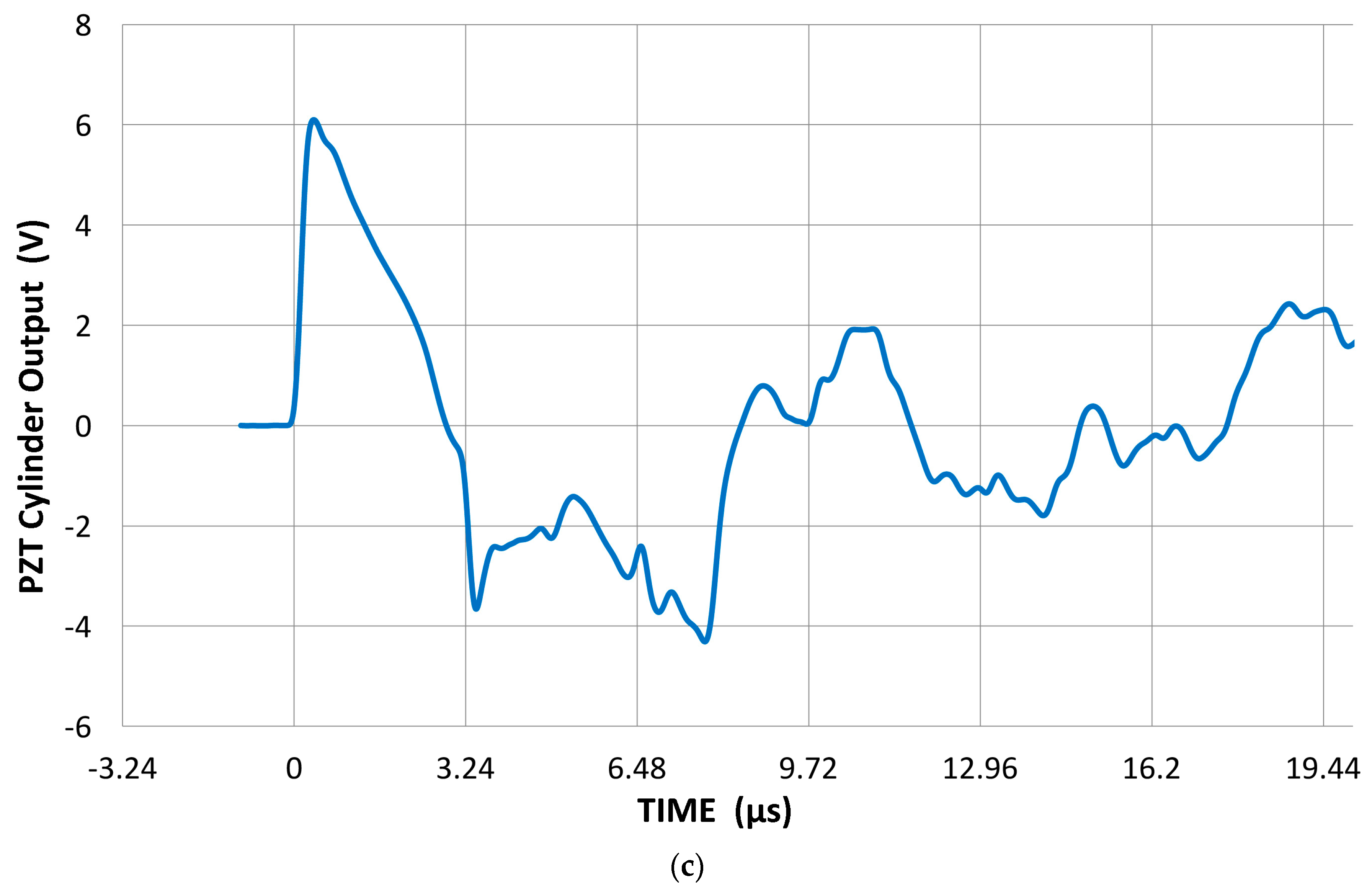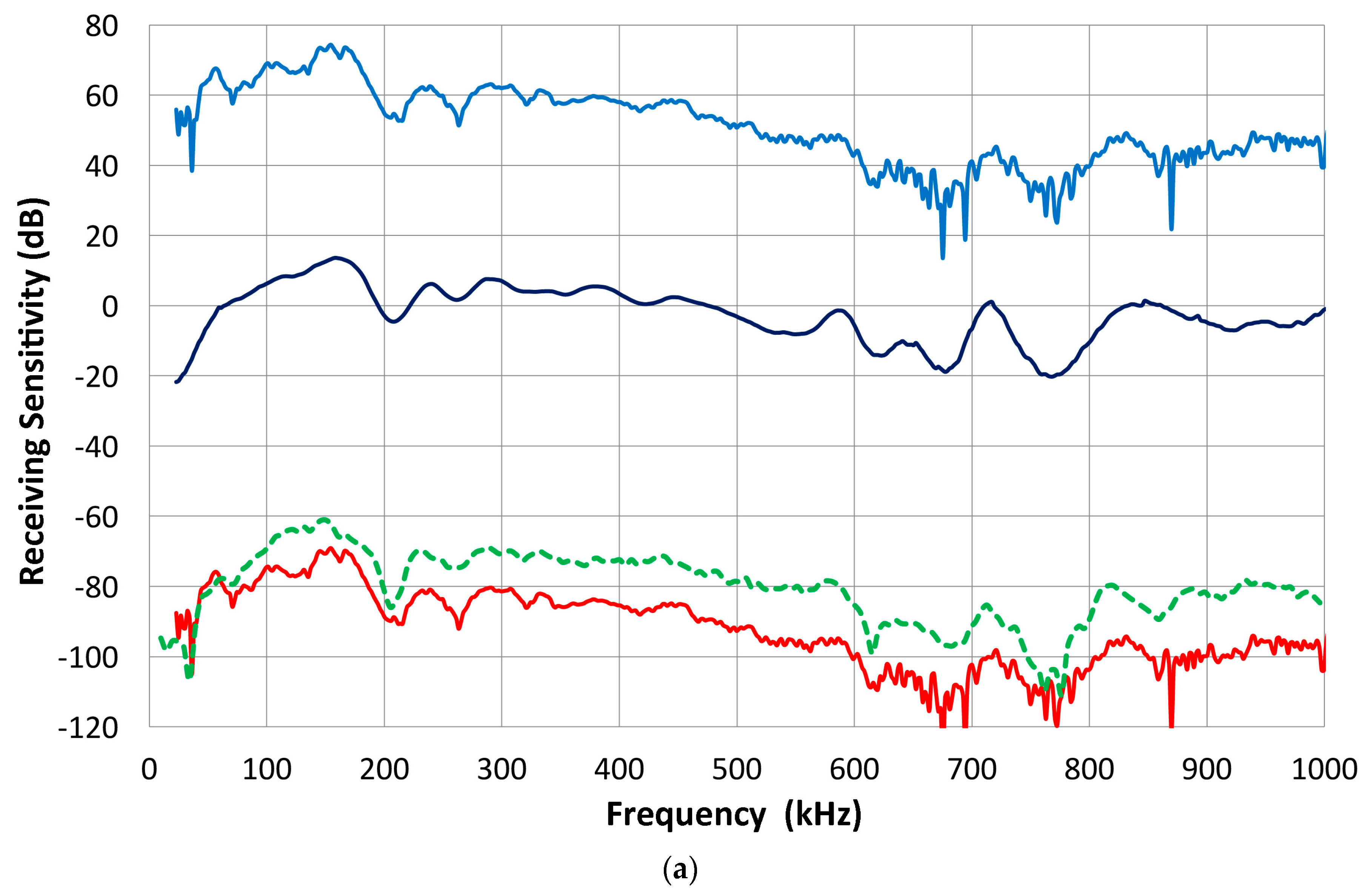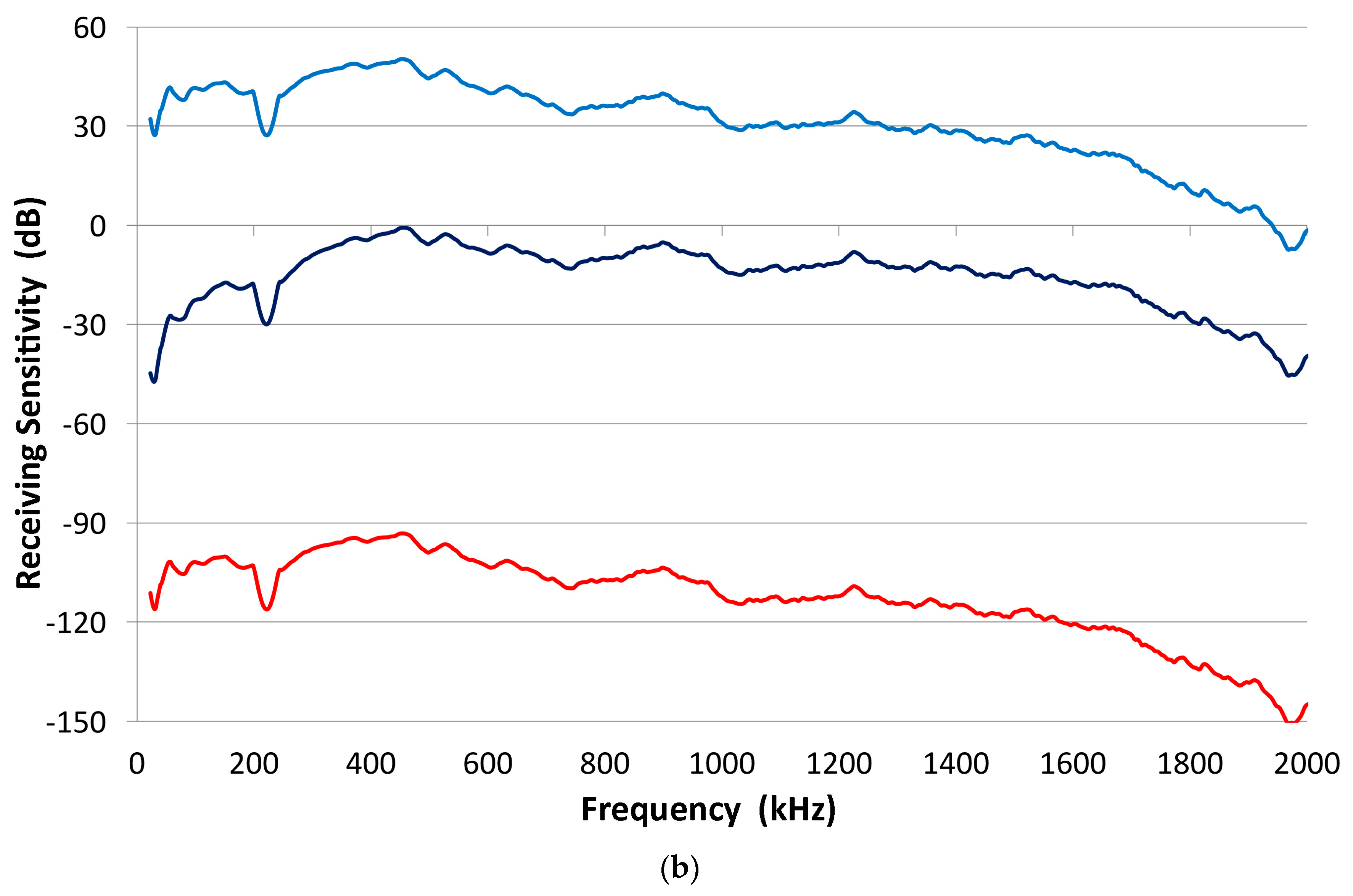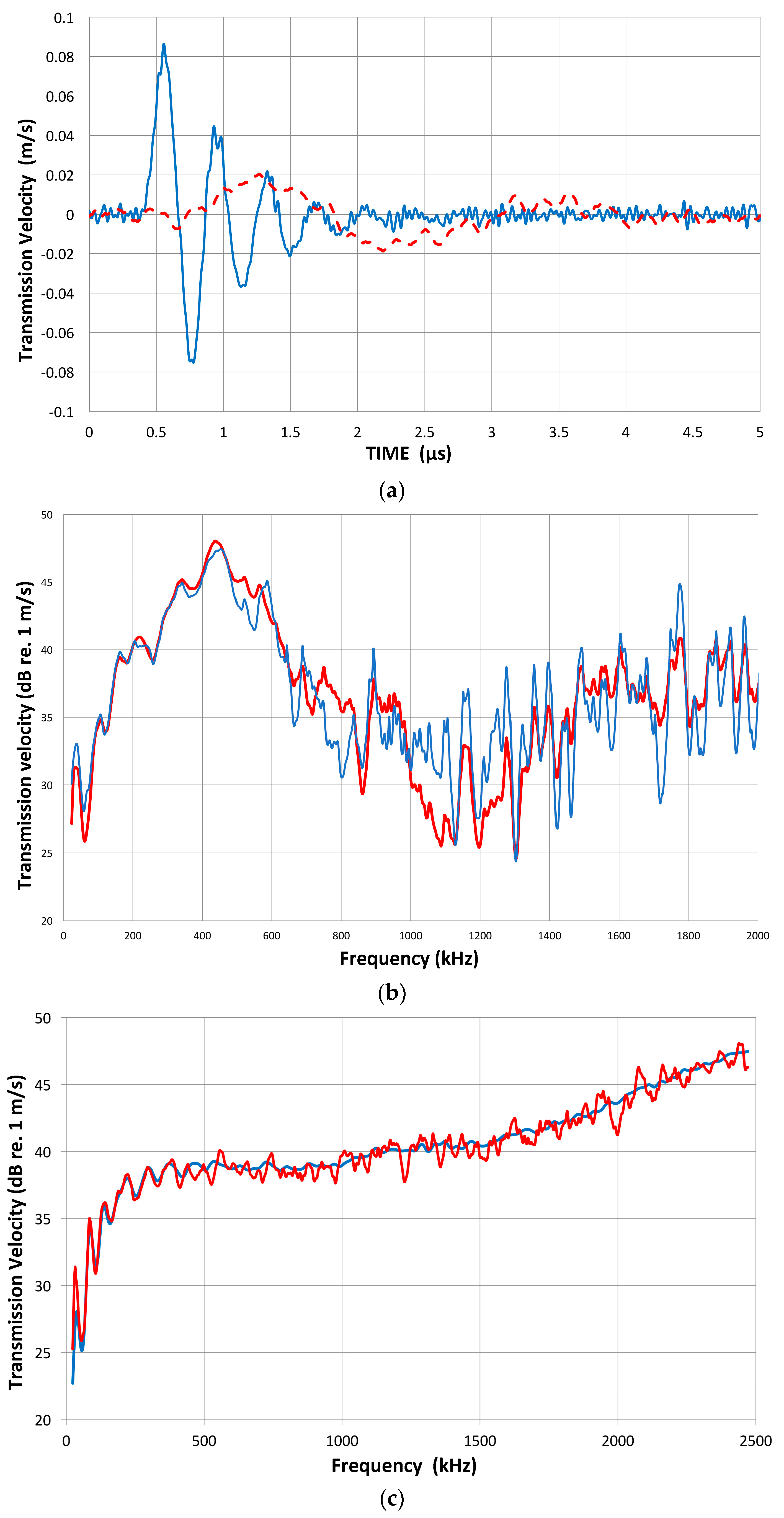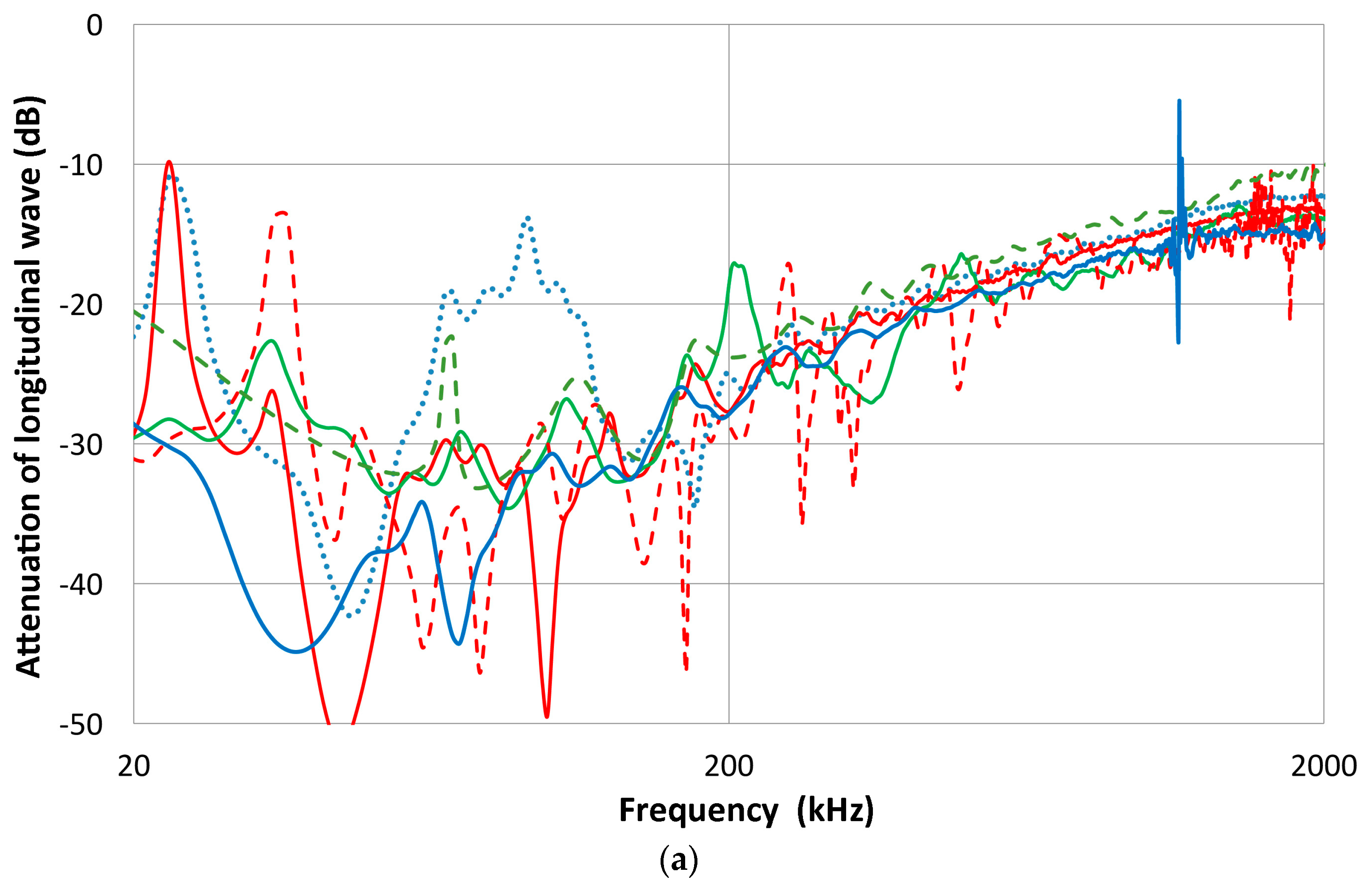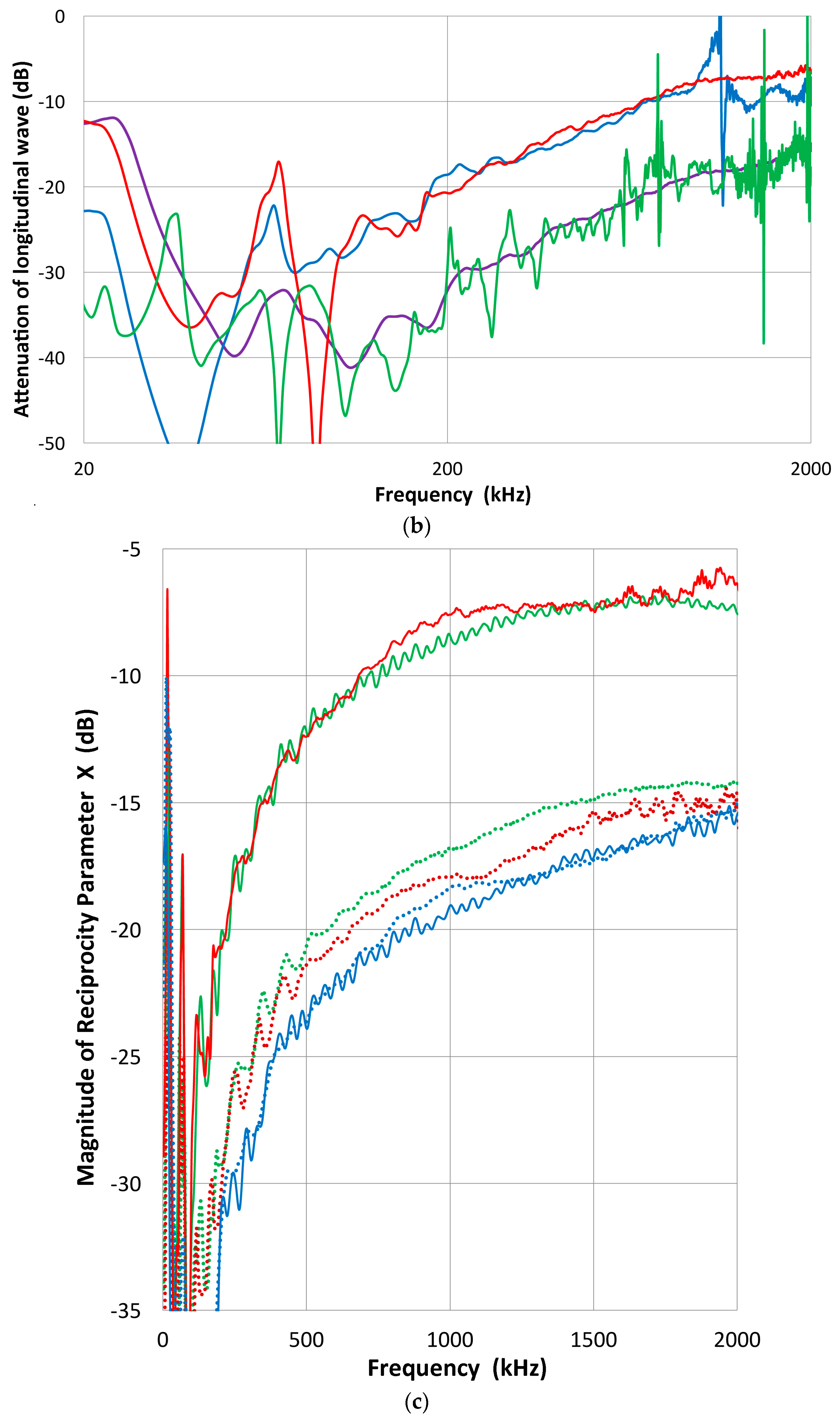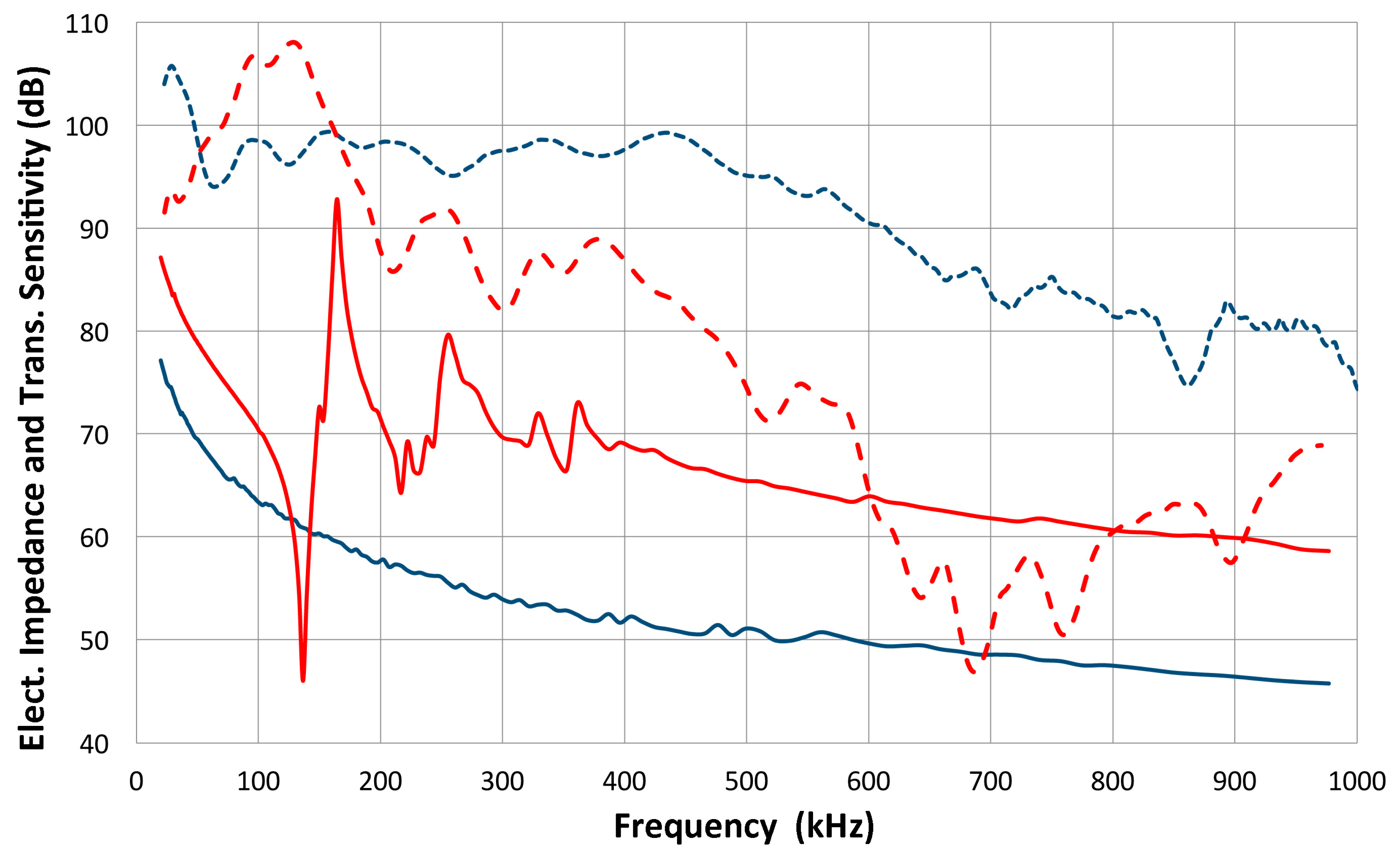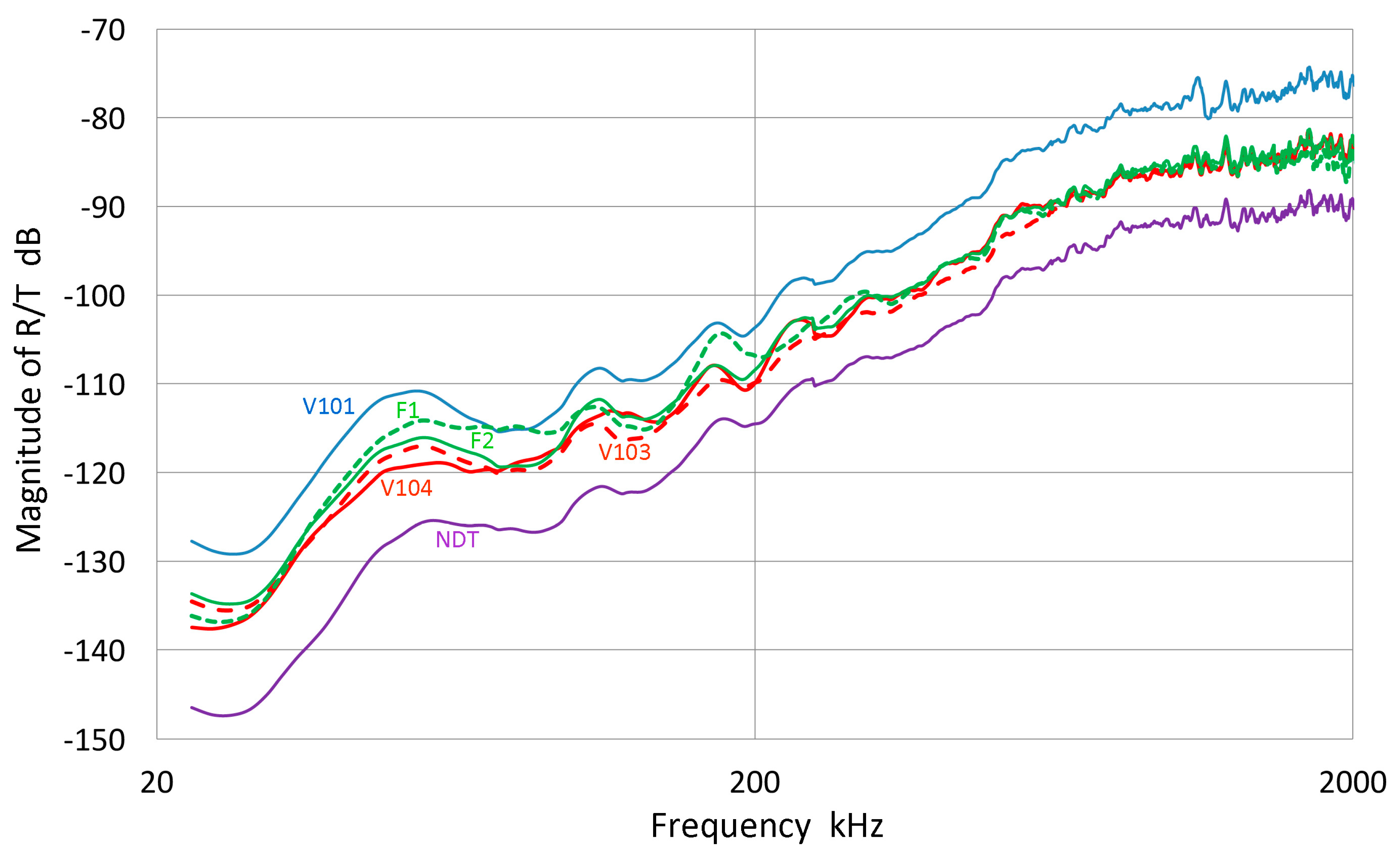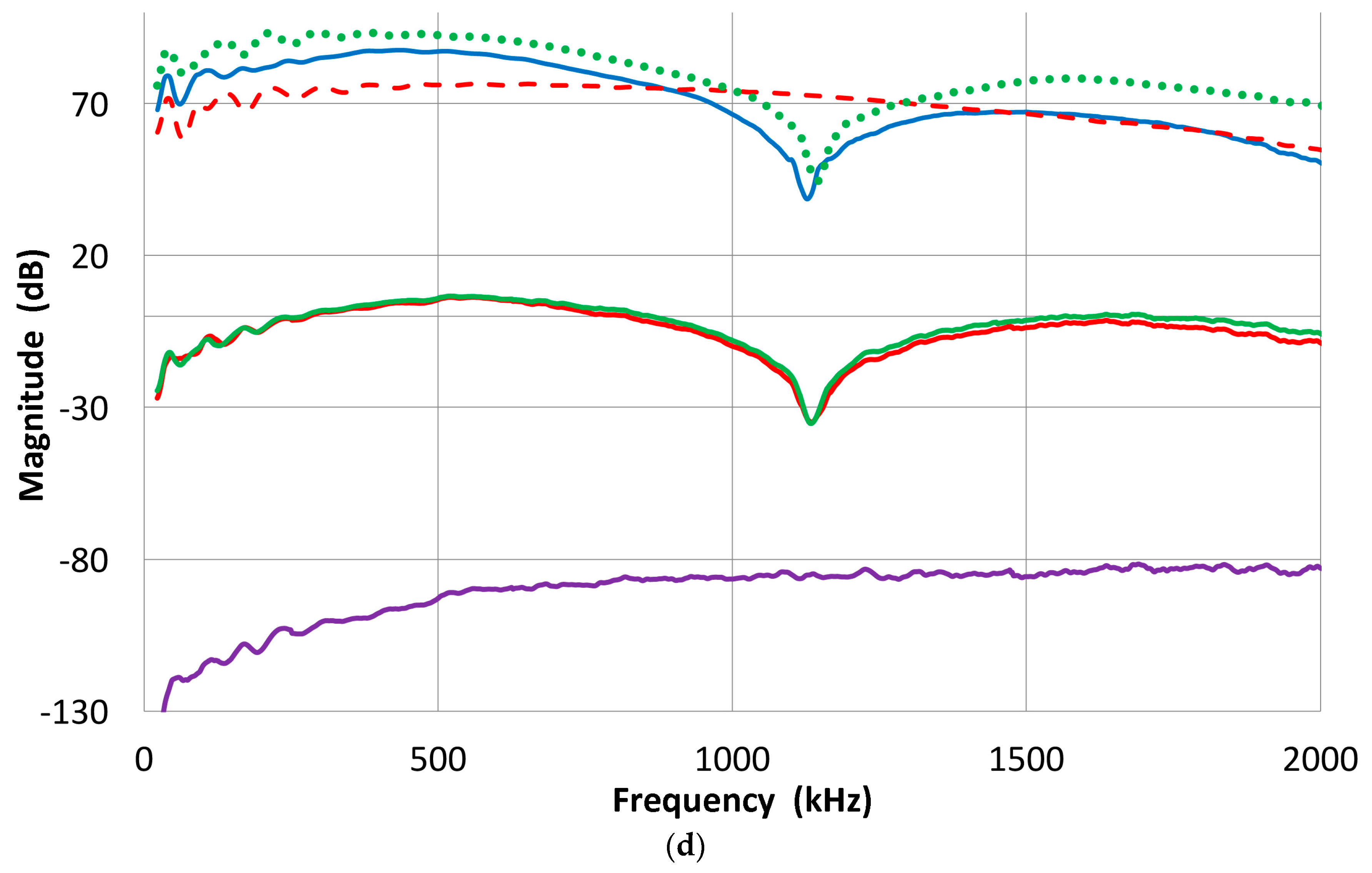1. Introduction
In ultrasonic testing (UT) and acoustic emission (AE) testing, transducers and sensors are essential components of a nondestructive test (NDT) system. The characterization of this component has been the subject of many studies over the years. Notable reviews on AE sensor calibration were provided by Sachse and Hsu, Hsu and Breckenridge and Hill [
1,
2,
3]. Recently, three books on ultrasonic transducers appeared; one is by Schmerr and Song [
4] and another edited by Vives [
5]. Both books have analyzed ultrasonic transducer behavior from the systems approach, providing a good foundation of system modeling based on the electrical equivalent circuit representation. Using the reciprocity principle and reflector responses, transducers immersed in fluid have been characterized satisfactorily. The third book is by Sherman and Butler [
6], which is directed toward underwater acoustics, but provides the most detailed discussion on piezoelectric sensing with an electroacoustic approach. In extending this lumped-parameter approach to cases of interest in NDT (or non-destructive evaluation, NDE), the need of the network analyzer presents an obstacle, since it is not commonly available in NDE laboratories. The other is the extensive use of contact transducers that often change their behavior from the air-loaded condition to a solid-loaded state. An example is shown in
Figure 1.
Figure 1a illustrates the three experimental methods used. A pulser generates a short pulse of a 200+ V peak with a few µs duration, which drives a transmitting transducer. In set-up 1, the surface normal displacement is detected by a laser interferometer at the center of the transmitter, T. In set-up 2, it is detected by a receiving sensor, R, which is acoustically coupled to T via a thin couplant layer. In set-up 3, T and R are separated by a solid transfer block.
Figure 1b shows the waveform from set-up 1. This AE sensor is made from a piezoelectric disk with minimal damping and its transmission curve (displacement vs. time by laser interferometry) reverberates to 0.9+ ms upon its excitation by a few µs-long pulses (see the top of
Figure 1a) with a persistent 30 kHz component. When it is in contact (so-called face-to-face arrangement, set-up 2) with a broadband receiver (
Figure 1c), trailing oscillations essentially dissipate by 80 µs. Moffatt [
7] discussed this front-face loading effect while developing rod-backed broadband sensors. It was also recognized in applying laser techniques to transducer calibration [
8]. Such changes and other damping effects are difficult to predict theoretically and have not been treated satisfactorily. In some well-damped transducers, laser techniques provided satisfactory results, although radial resonance effects are more difficult to eliminate. In the present study, laser interferometry is utilized as the basis for transducer characterization. This was discussed extensively by, e.g., Scruby and Drain [
8], but has so far not been widely used in NDE practice due to high cost. In UT transducer calibration, more advanced methods have appeared and the frequency range is extended to 20 MHz routinely [
9] and to 100 MHz in the laboratory [
10,
11,
12,
13,
14]. These include uses of direct measurement of particle velocity in water, time-delay spectroscopic methods, an optical multilayer hydrophone as a reference and pulse-echo with a reflector.
The reciprocity calibration methods have been well established for acoustic transducers and hydrophones. These also apply to some piezoelectric transducers. MacLean [
15] started with the laws of reciprocity requiring the condition of reversibility. Let us denote the transmission output of the i-th transducer due to an electrical pulse as
Ti =
ti ×
Vi, where
ti is the transmit transfer function and
Vi is the fast Fourier transform (FFT) spectrum of the pulse input. Here, the transducer output is measured in displacement.
Rj is the receiving displacement sensitivity spectrum of the j-th transducer. With the above notation (without separating the input spectrum), the law of reciprocity for transducers i and j is
which can also be stated as
This ratio is equivalent to the reciprocity parameter as defined by MacLean [
15]. In using the reciprocity approach, one must first establish the reciprocity of a transducer. While this reversibility requirement for the reciprocity calibration was in MacLean [
15] and Foldy and Primakoff [
16], it has become necessary only for an auxiliary transducer.
Attempts [
17,
18] have been made to extend this approach to contact piezoelectric transducers that are often damped for wideband applications. In such instances, however, the assumption of the reciprocal behavior of transducers as transmitter and receiver can no longer hold universally. Simple experiments reveal the breakdown of reciprocity. Three pairs of well-damped ultrasonic transducers show reciprocal and non-reciprocal behavior in a transmission-reception experiment using set-up 2, as seen in
Figure 2. Results are given in terms of FFT magnitude spectra of received signals. Each pair was directly coupled and one was excited by a short pulse and the other used as a receiver; for transducers i and j, the FFT spectrum of the output voltage is defined as
E˚
ij. Next, the roles are switched, yielding
E˚
ji, and the pairs of
E˚
ij and
E˚ji are plotted in
Figure 2. One pair shows almost identical waveforms (not shown) and their FFT spectra (as overlapping red curves) agree closely. This pair consists of two AET FC500 (2.25 MHz, 19 mm diameter) with similar design and reciprocal behavior is expected. The second and third pairs (green and blue curves) have spectra differing by 4.5 to 7 dB. These pairs are between the NDT Systems C16 (2.25 MHz, 13 mm diameter) and the Olympus V103 (1 MHz, 13 mm) or V104 (2.25 MHz, 25 mm). Thus, changes in the center frequency or element size are a possible cause for the reciprocity breakdown. The damping design may also be different since spectral curves are of completely different shapes in some combinations. Results from 25+ pairs indicate that these are usually not reciprocal. The reciprocity behavior is found in less than a third of the cases, even when the reciprocity condition was allowed to break down over some frequency ranges. Typically, reciprocity requires nearly identical transducer design and specifications.
In the above FFT analysis, we used the FFT routine of Noesis software from Enviroacoustics, ver. 5.8. The sampling interval is kept at 2 ns and zero padding is used to keep the sample length of 262,144 points, giving the frequency step of 1.907 kHz. In most cases, a smoothing filter was applied to reduce noise, cutting off the low frequency response below 20 kHz.
Hill and Adams [
19] showed that when the transmitting and receiving sensitivities of transducers are different, the ratio of the transmitting and receiving sensitivities for one of three transducers is required for the reciprocity equation expressing the receiving sensitivity. Following [
19], for a directly coupled pair of transducers i and j, the following expression is obtained, ignoring the effect of the couplant layer between them:
When the pair is coupled through a transfer block with the propagating medium transfer function of
Xij, it is written as
where
Xij =
Xji =
X is assumed in the reciprocity methods and
Eij =
E˚
ij ×
Xij.
As is normally the case in reciprocity calibration, we select transducer pairs of 1 and 2, 1 and 3, and 2 and 3. Here transducer 3 is the auxiliary transducer and needs to be reversible and 2 is the target transducer of the calibration. Using the same designation, Equation (3) leads to
From these equations,
E˚
12/
E˚
13 =
R2/
R3, we get
Combining, we have the following equation for directly coupled pairs
Or for pairs coupled through the transfer block
It is appropriate to name this Equation (6a) as the Hill-Adams equation. Here, there are six unknowns of
T and
R for transducers 1 to 3, but
T2 was unused and
T1 cancels out in Equation (5). To obtain
R2, three
Eij values and
T3 and
R3 must be supplied from the experiment. In general cases of differing transmitting and receiving sensitivities, Hill and Adams [
19] showed that the reciprocity calibration method is invalid without using the independently determined transmitting and receiving sensitivities of an auxiliary transducer. This condition of different transmitting and receiving sensitivities prevails in many piezoelectric transducers, thus posing a doubt as to the validity of the so-called “absolute reciprocity calibration” advocated by Hatano [
17,
18] and followed by others [
20,
21,
22,
23]. These researchers have all ignored the invalidity problem raised by Hill and Adams [
19].
This problem can be overcome when transmitting sensitivities are obtained using laser interferometry. This also provides receiving sensitivities as will be shown later. Using the laser-based measurement of T3 and R3, the formalism of reciprocity calibration, namely Equation (6), can be utilized in conjunction with the face-to-face procedure of set-up 2.
The potential for an alternate approach should be noted here: by conducting the bi-directional transmission-reception experiments for all the possible combinations of a set of transducers, one can in principle use the genetic algorithm optimization procedures to separate the transmitting and receiving sensitivities (see, e.g., [
24,
25]). When such a software is written, the needs for laser interferometry can be minimized.
ASTM standards for ultrasonic transducer calibration are limited to getting the flaw position and flaw size using of calibration blocks [
26,
27]. Transducer manufacturers typically provide a back-echo waveform and its spectrum, but not the transmitting or receiving sensitivities. For conventional ultrasonic tests, this is apparently adequate, since costly procedures are required to get other desirable transducer characteristics such as beam spread, focusing, and angular sensitivity as well as the spectral sensitivities mentioned above. However, it is still advantageous to have both transmitting and receiving sensitivities for many advanced applications. Two ASTM standards do exist for the primary and secondary calibration of AE sensors [
28,
29]. These are based on seismic pulse on a large transfer block, developed at National Institute of Standards and Technology (NIST) and based on the work of Breckenridge et al. [
30], and are used for the calibration of the surface wave sensitivity. Burks and Hamstad [
31,
32] reexamined the NIST procedures and suggested revisions. One of them is to use measured displacement rather than analytical calculation since the capillary break source is elliptical rather than a point. At present, however, no standards organization provides a calibration service based on these two standards. Also, no ASTM standard exists for AE sensor calibration for normal incidence waves.
AE sensor manufacturers typically provide a sensitivity curve based on face-to-face calibration. This calibration procedure has been treated as proprietary information and described only inadequately. Calibration curves are usually in reference to the reference level of 1 V/µbar, but this reference remains undefined. The ASTM E976 standard guide [
33] is often referred to as the basis, but E976 specifically excludes the face-to-face procedure. This method does benefit from ease of set-up, reasonably good repeatability and the ability to handle long-duration signals of high-sensitivity (undamped or minimally damped) AE sensors. Commonly used AE sensors reverberate beyond 1 ms when free and often over 200 µs even coupled to a metal block, enlarging the needed size of a transfer block to inconvenient sizes of over 1 m. Recent papers [
34,
35] indicate renewed interest in this method and we will consider various aspects of the face-to-face procedures. However, it is suspected that the calibration unit is misconstrued in [
34] regarding the velocity calibration, and their results are about 140 dB off the manufacturer’s calibration of the PAC R15 sensor. In sum, currently no applicable standards for calibrating ultrasonic transducers and AE sensors exist. This is indeed a dire situation for NDE professionals.
Before embarking on the main topics, some valuable early works on AE sensors should be brought up. Moffat et al. [
7] developed rod-backed wideband velocity-sensitive sensors. These used 5 MHz PZT disks, backed by impedance-matched brass rods. Their 3.2-mm-diameter sensor achieved a smooth spectral behavior from 20 to 700 kHz with a 10 dB decrease according to the calibration at NIST. Another worthy sensor design used a polyvinylidene difluoride (PVDF) foil sensor with a small aperture backing. Chang and Sun [
36] showed one design with an aperture 1.5 mm in diameter, which provides a NIST-sensor-like displacement-sensitive sensor. With a rod backing, it gives velocity-sensitive sensors as in [
7].
We attempt here to examine the inadequacy of sensitivity calibration methods for AE sensors available today and to provide workable solutions based on physically measureable quantities. We start with the laser-based calibration of transmitting devices. This is then used to calibrate receiving sensitivities of sensors/transducers. Methods of validating both characteristics in combination are introduced in order to circumvent problems of extraneous vibrations that are found in some transmitters without front-face loading. Effectiveness of the face-to-face calibration method is evaluated, especially in connection to the ill-defined “V/µbar” reference in reporting contact sensor calibration. Displacement vs. velocity calibration terminology is clarified. Finally, reciprocity calibration methods are critically examined since the commonly used methods are found invalid without independently measured auxiliary transducer sensitivities. In lieu of these invalidated reciprocity methods, a tri-transducer method is developed. This new method provides calibration results comparable to laser-based direct and indirect methods.
2. Transducer Sensitivity Calibration—Transmission
The use of laser interferometry for transducer calibration is straightforward as discussed by Scruby [
8], but the surface loading effects need to be considered as extraneous vibrations sometimes occur when the transducer front face is free, only facing air. Commercial interferometers of various design are now available, although their uses have been limited due to high cost. Notable interferometry works came from UK-NPL [
11,
37] for the determination of acoustic pressure in water for the validation of reciprocity calibration of hydrophones and for AE sensor calibration with a through-transmission block. We reported on getting transfer functions of AE transducers [
38], and other calibration methods were explored elsewhere. The work of Goujon and Baboux [
20] was a significant advance as they used a laser interferometer to verify the displacement of surface pulse and obtained the sensitivity for the surface-wave reception of PAC µ-80 sensors. It was comparable to the representative calibration curve published by the manufacturer (using the NIST procedure). Keprt and Benes [
22] followed up this study and reported the surface wave–receiving sensitivity of PAC UT1000 sensors. They used two reciprocity methods and the NIST capillary break method and the results match each other well below 300 kHz and reasonably (10 dB) up to 1 MHz. In these two studies, however, key details are unavailable for the reciprocity methods, so their validity in view of the Hill-Adams analysis cannot be assessed.
In our studies that have been directed toward normal incident waves, we have used a displacement-sensitive laser interferometer (Thales, LH140, Mach-Zehnder heterodyne type, 20 MHz bandwidth with a sensitivity of 0.1 V/nm at Aoyama Gakuin University, Sagamihara, Japan; Dr. H. Cho graciously conducted measurement), using set-up 1. Three typical transmission curves with a fast initial rise and slower decay with several oscillations are shown for broadband ultrasonic transducers (Olympus V101, V103 and V104; V101 is 0.5 MHz, 25 mm) in
Figure 3a with their corresponding FFT magnitude in dB scale (
Figure 3b). The peak displacement values are 10–12 nm and represent the out-of-plane displacement of the center region of the transmitter with a 100-times signal averaging. Except within 1 mm from the edge, the amplitude variation was less than 0.5 dB. The high voltage excitation pulse used was of a short rise time (0.2 µs) to the peak of 220 V nominal and decays to 10% in 1.5 µs or 3 µs to 0 (see
Figure 1a). The FFT spectra of three more transducers (two FC500, NDT C16) are shown in
Figure 3c. These are shifted in time and level as noted.
The observed displacement waveforms are basically of monopolar shape with trailing oscillations. This feature results from the forward radiation at the front face and the presence of the absorber behind the piezoelectric element, as predicted by Redwood and Kossoff [
39,
40]. The peak displacement value is approximately 50 pm/V. This displacement is about one half that of a typical lead-metaniobate piezoelectric element, which is presumed to be used in these transducers. Alternate elements of PZT ceramics are expected to produce displacements that are at least a few times larger. The other half of the piezoelectric displacement is radiated backward into the absorber and mostly damped. In addition, it is expected that a higher acoustic impedance of the sensor face material (usually alumina) causes a 2.3 dB reduction and also gives back reflection.
The FFT magnitude transmitting spectrum is relatively smooth for V104 (nominally 2.25 MHz center frequency), as can be seen in
Figure 3b. The spectrum of V101 (0.5 MHz) exhibits a broad peak just below the nominal center frequency and lesser oscillations, while that of V103 (1 MHz) shows many peaks and a sharp dip just under 1 MHz, its center frequency. This figure shows that extraneous oscillations are indeed present from the lack of front-face loading of V103 (and V101 to a lesser extent). With face-to-face arrangements (set-up 2), these are absent since it was seen in
Figure 2b that these transducers produced smooth spectral curves in combination with the NDT C16 (2.25 MHz) receiver. The latter (C16) as a transmitter also showed large oscillations above 1.4 MHz in the interferometry spectrum (
Figure 3c), but
Figure 2b also exhibited a smooth spectral curve in combination with V103 as a receiver. Thus, the front-face loading most effectively suppressed extraneous vibrations in these three transducers (V101, V103 and C16) used as transmitters. Two more transmitting spectral curves are shown in
Figure 3c for two AET FC500 (2.25 MHz, 19 mm). These generate an output range similar to that of V104, but show additional oscillations overall, especially at low frequencies below 250 kHz. It appears that the low frequency oscillations come from radial resonance that was not suppressed adequately. From the comparison of these six transmitting spectral curves, we decided to use V104 as the reference transducer and use the remaining five for confirmation by avoiding the range where irregular changes are observed. The raw FFT spectral data contained noise and it was reduced by using the 25 point smoothing Savitzky-Golay algorithm [
41]. Differences can be seen in
Figure 4. The blue curve is after smoothing and the red one is the raw FFT magnitude spectrum, as obtained from FFT (shifted down 10 dB for visibility). The smoothed blue curve does match well and follows the middle of the noisy red curve.
The magnitude spectra in
Figure 3b,c do include the spectrum of the high voltage (HV) electrical pulse, which is a slowly decreasing function with frequency. It varies only slightly (within ±1.5 dB) among most transducers used. The transmission characteristics of V104 are shown in
Figure 5 up to 5 MHz. This higher range covers the frequency of interest in UT. The HV pulse spectrum for the V104 test is included as the top curve, marked 1. The displacement transmitting spectra of V104 are curves 2 and 4. The latter is corrected by subtracting the HV FFT spectrum, indicating much less frequency dependence of V104 transmission and showing a broad peak at 2.6 MHz. The value of Q is 1.7. By multiplying the angular frequency, these curves are converted to show the velocity response of V104 transmission, shown as curves 3 and 5, with or without the HV electrical pulse spectrum. It was confirmed that the discrete differentiation of the displacement waveform using the Savitzky-Golay algorithm [
41] results in an identical magnitude spectrum as that due to 2 π
f multiplication (
f = frequency), shown here.
Utilizing laser interferometry measurement (set-up 1), V104 is identified as a suitable reference transducer for providing the source of the displacement pulse. The displacement (and velocity) transmission characteristics will be used next for obtaining mutually consistent calibration of transducers using set-up 2.
4. Piezoelectric Sensing
In order to confirm the basic sensing mode of piezoelectric sensors, we determined the response of piezoelectric elements of known piezoelectric constants and compared predicted values with observed voltage outputs. Three PZT-5A elements were used. Two disks and a cylinder were used as summarized in
Table 1.
These PZT elements were coupled on the face of V104 using a thin brass foil (60 µm thick) and Vaseline couplant. Here, three PZT output signals are shown in
Figure 12, when a displacement pulse (
Figure 3) with the peak value of 11.4 nm is applied.
Figure 12a is for the 400 kHz disk without any backing, while
Figure 12b shows the response of the cylinder that had a brass backing plate of 3.2 mm thick × 35 mm square. This backing is a minimal one, however. The disk responded with a short rise time to a peak, then the output slowly decayed, and dropped sharply upon reaching the transit time of 1.25 µs as the displacement pulse reached the back face. The elastic pulse is reflected (without backing) and the output polarity is reversed since the reflected wave now has the opposite polarity. When the initial elastic wave front reaches the back face, charges from the piezoelectric polarization are damped on the back electrode. This causes the voltage drop observed. The reflected elastic wave then carries the opposite charge to the front. At 2.5 µs, another reversal occurred. This behavior is as predicted by Redwood [
39] for a PZT element without backing. The cylinder element also showed a rapid rise, but output decay was faster during the pulse transit. By the time the pulse reached the back face at 3.24 µs, the output reached a below-zero level. In this case, a brass backing plate was coupled and the effect of the reflection was halved. Again, this follows Redwood’s theory, although our backing was less than perfect and had substantial residual reflection. These two types of sensor output responses are typical of piezoelectric element behavior with or without an absorbing damper behind the back face. In fact, most transducers produce the second half-cycle (e.g.,
Figure 7b) even though many of them are well-damped and produce a monopolar pulse in transmission. This is apparently the cause of the nearly universal receiver-transmitter spectral ratio behavior, shown in
Figure 11 and modeled by the full-cycle vs. half-cycle sinewaves. The rise times of the PZT response are 0.34–0.45 µs and 0.1 to 0.2 µs slower than the displacement pulse of V104 (cf.
Figure 3) since the elastic response time has to be convolved. Thus, the input and output rise times are comparable and the output waveform before the back-face reflection is the same monopolar shape as the displacement input; it is evident that the response is not the time derivative of the input. When the reflection and subsequent reverberations are included, the response waveform can be construed as an apparent velocity-response output. Such an example can be seen in
Figure 12c, for the 1 MHz disk response with and without backing, especially the latter. Again, the unbacked disk shows full-cycle oscillations, while the backed disk had a reflection amplitude of about one-third. Note that the output signals represent the 1 MHz thickness vibration of the PZT element initially, followed by radial oscillations that become dominant after 5 µs.
The observed response shows the peak output of 6.0–7.6 V (into 100 MΩ), and the observed sensitivity is 0.53–0.67 V/nm. The piezoelectric coefficient h33 for PZT-5A is 1.60 V/nm. Since the acoustic impedance mismatch from the V104 alumina face to the PZT results in a transmission coefficient of 0.766 and two couplant layers, and brass foil added an attenuation factor of 0.929, the predicted value is 1.41 V/nm. The observed sensitivity is 4.7 to 6.7 dB below the predicted response. This difference is likely from the method of piezoelectric coefficient determination that is usually conducted statically with a higher input impedance device or at much lower frequency. Thus, it is within a factor of two and the present procedure can be considered to generate voltage output in response to the displacement of a PZT element.
Recently, Sause [
46] examined the pulse generation behavior of unbacked and perfectly backed PZT-5A disks (3 mm thick, 10 mm diameter) using a multi-physics modeling method [
47]. He applied a cosine bell–shaped displacement of 2 µs duration. The output from the unbacked disk (
Figure 13) shows a bipolar response, as expected (black curve). Note that the reflected signal is 50% higher than the initial pulse height and oscillations persist beyond 15 µs. The stronger second pulse was commonly found when the transfer functions of AE sensors were experimentally determined [
38]. It was interpreted as the dumping of electrical charge at the back face from the arriving initial mechanical pulse and the reflection of an opposite polarity mechanical pulse. With perfect backing behind the disk and the PZT element terminated with 10 kΩ and 195 pF, the initial pulse is followed by an opposite polarity pulse induced by electrical impedance mismatch, as shown as the red curve in
Figure 13. Because the incident elastic wave passes through the back face of the PZT element without reflection, electrical charge build-up continues until the tail end of the incident wave reaches the back face at 2.8 µs (including the propagation time through 3 mm PZT). The absence of the reflected elastic wave raises the peak value observed. The charge starts to dissipate into the termination resistor and an electrical impedance mismatch results in a bipolar output pulse. Such mismatched electrical loading conditions are the norm in the AE/UT field, and the conversion of monopolar input to bipolar output pulse shapes is prevalent. This can explain the general trend reported in the previous section, especially in connection to
Figure 11. Another possible source of the bipolar response is the excitation of radial response in the PZT disk. The backing is matched for the longitudinal waves, but the radial compliances remain unmatched. More physics-based analysis of piezoelectric sensing needs to be conducted.
This part demonstrated:
- (1)
The origin of signal generation from a piezoelectric sensor element is best correlated to its displacement which can be measured directly.
- (2)
The source of bipolar signal generation is from the reflection on the back face when undamped, while for well-damped sensors it is likely to originate from the electrical impedance mismatch and partly from electrical charge transfer during elastic wave motion.
5. Velocity Response of a Transducer
We have shown that piezoelectric sensors generate output voltages responding to displacement input. It can still be described in terms of the time derivative of the displacement input, namely the particle velocity. The standard approach started with ASTM E1106, which treats a sensor output as proportional to the displacement function with a typical unit of V/nm. However, its FFT magnitude can be converted to express the sensitivity in reference to the input velocity function. This is accomplished by the multiplication of the 2 π
f factor to the input function according to an identity in Fourier transform theory. When one divides the sensor output function by the velocity input function, the velocity sensitivity spectrum is obtained with a typical unit of V/m/s or Vs/m. The transmitting displacement sensitivity spectra presented earlier in
Figure 3,
Figure 4 and
Figure 5 can be treated in this manner. In
Figure 5, curve 2 is the displacement function (in nm unit), while curve 3 is the velocity function in the unit of m/s. Along with the 2 π
f factor, remove a factor of 10
−9 (changing from nm to m), corresponding to 180 dB subtraction on the dB scale. A note of caution: one cannot multiply 2 π
f to a receiving displacement sensitivity spectrum in an attempt to get the velocity response. Instead, you need an opposite operation: divide by 2 π
f and add a factor of 10
+9.
In the AE field, it is common to find the use of µbar in place of m/s as the unit of velocity. This originated from Dunegan’s use in 1968 of a hydrophone calibration scheme in characterizing a reference transducer [
48]. At that time, he took it as the acoustic pressure in water and obtained calibration up to 400 kHz. Today, the frequency limit for miniature ultrasonic hydrophone calibration is extended to 20 MHz [
9].
The physical meaning of 1 µbar reference pressure has become obscure over the years, as it has not been articulated in any AE standard documents. When an immersed AE sensor receives the pressure wave, most of the wave is reflected back into water as the acoustic impedance of the sensor facing or sensing element is usually much higher than that of water. The transmitted pressure wave generates particle velocity in the sensor facing or the sensing element. However, this pressure cannot be measured. Thus, it is impractical to use it as the basis for calibration. In a recent study, Burks and Hamstad [
35] concluded that the conversion procedure of the sensor response to the V/µbar reference is illogical and arbitrary unless one measures “the transient output pressure as a function of frequency from the driving transducer”.
The most logical interpretation of the V/µbar reference is that of pressure in water, as practiced in the underwater acoustics field for hydrophone calibration [
49]. In the immersion tank where a hydrophone is calibrated, the acoustic pressure field is known as a function of frequency. The acoustic pressure in water is defined as the product of the acoustic impedance of water (1.48 MPa/(m/s)) and the particle velocity. Thus, the pressure of 1 µbar (=0.1 Pa) in water corresponds to 67.6 nm/s. By placing a reference transducer at the position of known acoustic pressure, it is calibrated as a function of frequency. This can then be combined with a broadband transmitter in face-to-face arrangement, from which the transmitter output can be calibrated in reference to equivalent acoustic pressure with the unit of µbar. Subsequently, a sensor under test is substituted for the reference transducer and calibrated in terms of the V/µbar reference. With this interpretation, the commonly used reference of AE sensors, 1 V/µbar, can be related to the physically-based reference of 1 V s/m. That is, 0 dB (in reference to 1 V/µbar) is 143.4 dB in reference to 0 dB at 1 V s/m. Alternatively, xx dB in reference to 1 V s/m = xx − 143.4 dB in reference to 1 V/µbar.
Several receiving sensitivity curves for common AE sensors are shown in
Figure 7. These have a peak sensitivity of around 0~15 dB in reference to 0 dB at 1 V/nm. After converting their response to volts per unit velocity of 1 m/s, we have the velocity response curves for two of them (R15a and Pico) shown in
Figure 14. Curves plotted on the lower side are further converted in reference to the scale of 0 dB at 1 V/µbar. For PAC R15a, the calibration provided by the manufacturer is plotted as the green curve, just above the lower velocity spectrum. Their values are typically 10–20 dB above our calibration for >0.1 MHz. The shape of this curve matches better with the displacement calibration. This discrepancy exists for almost all other sensors examined, not just from this manufacturer, implying a possible existence of industry-wide systematic error. An interim solution is to add 72–74 dB to the manufacturer’s calibration, thereby obtaining the displacement calibration in reference to 0 dB at 1 V/nm.
It is worthwhile to compare direct differentiation with the velocity conversion procedure from E1106, which we adopted here. The former gives intuitive displays in place of the abstract 2 π
f multiplication step. A displacement waveform from a transmitter can be differentiated with time, providing a velocity waveform (or particle velocity according to the UT terminology). Two of the displacement waveforms, V101 and V104, in
Figure 3a, are differentiated using the Savitzky-Golay algorithm [
41] and are shown in
Figure 15a (V in m/s, t in µs). The amplitude for V101 is four times smaller. The rise time (zero to peak) was reduced from 0.85 to 0.4 µs for V101 and from 0.25 to 0.15 µs for V104. The waveform changes from monopolar to bipolar. FFT peaks are at 430 kHz and at 2.6 MHz, respectively, close to their nominal values (
Figure 3 and
Figure 5). These peaks are more pronounced than the original displacement spectra. Other UT transducers give similar results. The FFT spectra are compared with the 2 π
f multiplication curves in
Figure 15b,c. The differentiated V101 spectrum (blue curve) is noisier, but it follows the 2 π
f counterpart (red) up to 700 kHz (
Figure 15b) well. The differentiated V104 spectrum (blue,
Figure 15c) also matches the 2 π
f counterpart (red) to 2.5 MHz and is smoother than the 2 π
f curve. It is clear that the velocity conversion procedure from E1106 is valid and is simpler. However, the direct differentiation does provide the velocity waveform and numerical values without the inverse FFT procedure.
The above discussion shows that it is unproductive to classify a sensor to displacement response or velocity response without specifying the frequency range or the flatness of response. NIST-type conical sensors with a large-mass backing clearly have a broad range of flat displacement response, while typical accelerometers are designed to produce nearly flat wideband acceleration response below the resonance frequency. Common AE sensors have been designed for resonance-based peak sensitivity, while newer designs start to broaden the peak sensitivity ranges.
This section leads to
- (1)
The clarification of pressure calibration references in terms of 1 V/(m/s) and 1 V/µbar.
- (2)
Demonstration of the equivalence of two conversion methods to velocity.
7. Conclusions
Outstanding issues of sensitivity calibration methods for ultrasonic and acoustic emission transducers have been examined. Determining spectral sensing properties is of utmost importance, especially in AE sensors, but recent research activities in this area have been low. In addition, today’s emphasis in this field has been to model the sensor behavior using the lumped parameter approach so that it can be integrated into systems modeling. On the other hand, physics-based analysis of piezoelectric sensing has been limited until recently. With new tools available today, such as laser interferometers and advanced modeling methods, we are closer to the goal of finding a suitable and workable approach to transducer calibration and clarifying underlying sensing mechanisms.
Laser-based displacement measurement leads to the determination of transmitting sensitivities of transducers. While simple in concept, some transducers generate extraneous vibrations on the front surface when it is free from solid contact. This issue was overcome by a suitable selection of a transmitter and by using an indirect method through the use of receiving sensitivities of other transducers. It was then possible to obtain mutually consistent transmitting and receiving sensitivities. The results also establish the foundation for face-to-face calibration methods, which were beset by the uncertainty of input parameters without access to the transmitter face. Further, it is discovered that the receiving and transmitting sensitivities of over 20 transducers are always different, while their ratios exhibit unexpected similarity. The latter characteristics are traced to the monopolar pulse generation of damped piezoelectric transducers as a transmitter and, as a receiver, bipolar received signals due to the reflection on the back face. This occurs even in transducers with good backing, likely from electrical impedance mismatch and charge transfer during elastic wave motion.
The observed difference in the receiving and transmitting sensitivities of a transducer leads to the invalidation of reciprocity calibration methods for piezoelectric contact transducers. The issue was raised in 1979 [
19], but users of reciprocity calibration have ignored the fact that a separate measurement of the ratio of the transmitting and receiving sensitivities is required. We have also measured the reciprocity parameters
X in the case of through-transmission and found this to be dependent on transducer pairings, sizes, frequency, etc., in direct conflict with its definition in the reciprocity calibration methods. These are also not reversible in cases of different-sized pairs. In the end, however, parameters
X and a transfer block were found unnecessary. In place of the reciprocity calibration, the tri-transducer method with a face-to-face set-up has emerged to be a validated calibration procedure.
Displacement vs. velocity calibration terminology is examined, in view of the ill-defined “V/µbar” reference used in the commercial reporting of sensor properties. It even found a way into standard documents [
35]. Returning to the origin of its introduction by Dunegan [
48], the definition from hydrophone calibration standards clarified the reference. The procedure is given for converting between the velocity sensitivities in the reference to the unit velocity of 1 m/s and to the acoustic pressure of 1 µbar in water.
It is demonstrated that three methods discussed here, the direct, indirect and tri-transducer methods, provide reliable sensor calibration results that are consistent among them.
